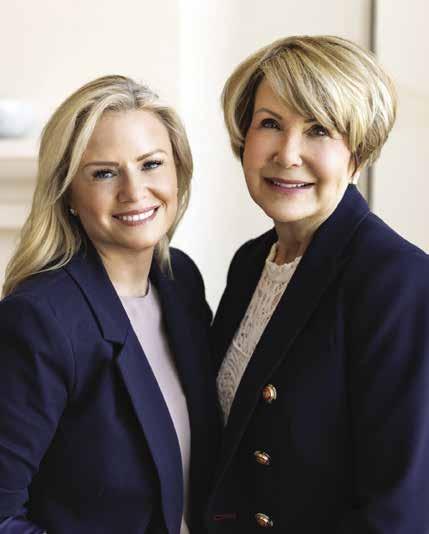











































My name is Bryan Palmese and I’m the manager of the Bellevue Club Hotel. I’m sure all of you know that we have a gorgeous 66-room boutique hotel on the property, but perhaps many of you haven’t had the opportunity to get to know us. I encourage you to change that!
Travel, in some way, shape or form, has always been a part of my life. Visiting new places, experiencing different cultures and tasting the cuisines throughout the world is what fills my soul with happiness.
Each day when I step foot into the Hotel, I tap into my previous travels to recall how that property made me feel. I want every member and guest that I connect with daily to feel like they are the most important person staying with us. Our outstanding team takes pride in providing an elevated, luxury experience to all guests, while ensuring comfort and accessibility.
The Bellevue Club is a unique property, and we embrace our mantra, “Stay Well,” each day, offering our guests a tranquil home-away-from-home experience.
If you haven’t enjoyed a staycation in the Hotel, I highly encourage a visit—especially if you work from home. Our stunning and spacious guest rooms offer a refreshing change of scenery, perfect for escaping cabin fever. Let us take care of your worries while you relax and use the Hotel as your home base for an extended weekend or a mid-week reset.
Additionally, we’d love to host your out-of-town guests. Don’t forget that they have access to the same excellent rates that members do.
We hope you enjoy another stunning summer in the Pacific Northwest and that your travels are full of safe, memorable adventures. I look forward to seeing you around the Club.
Best regards,

Bryan Palmese
bellevueclubhotel.com
CLUB REFLECTIONS (ISSN 1096-8105) is published bi-monthly by the Bellevue Club, 11200 S.E. 6th, Bellevue, WA 98004. Copyright 2019 by Bellevue Club. All rights reserved. Reproduction in whole or in part without express written permission is prohibited. Publication number 715390. Periodicals postage paid @ Bellevue, WA, and additional offices. Editorial, Advertising and Circulation Office: P.O. Box 90020, Bellevue, WA 98009 (mailing address); 11200 S.E. 6th, Bellevue, WA 98004 (street address); telephone 425.455.1616. Produced by Vernon Publications, LLC, P.O. Box 970, Woodinville, WA 98072-0970. POSTMASTER send address changes to BELLEVUE CLUB REFLECTIONS, 11200 S.E. Sixth St., Bellevue, WA 98004.







MOTHER’S DAY BRUNCH MAY 11
Shower the moms and mother figures in your life with love and gratitude at our delicious, seasonal buffet. $80/members, $40/children 4-12, ages 3 and under, free.
1 MINGO MANIAC: MUSIC, BINGO & FUN | 6-8 PM
1 PUBLISH YOUR PASSION 12:30-2 PM 2 FAMILY GYM NIGHT | 5:30-8:30
2, 9, 16, 23, 30 BATTLE OF THE BARTENDERS 5-8 PM
3, 10, 17, 24, 31 INFLATABLE OBSTACLE COURSE 6-7:30 PM
3, 10, 17, 24, 31
BREAK EVEN BOTTLE NIGHT 5-10 PM 4, 11, 18, 25 WATER RUNNER | 5-6:30 PM
THE WINEMAKER: WEATHEREYE WINES | 4-5:30 PM 8-11 MOTHER'S DAY SALE | ECLIPSE 9 MOTHERS CELEBRATING MOTHERS 6-8 PM 13 MEET THE DISTILLER: MONSON RANCH | 5:30-7 PM
SUNDAY FAMILY TABLE DINNER South Cosmos | 5-7 PM LIVE MUSIC
Atrium | May 2, 9, 23, 30
5:30-8 PM
Atrium | Jun 6, 13, 27
5:30-8 PM HALF PRICE BOTTLE NIGHTS
Cosmos | Mondays Splash | Sundays

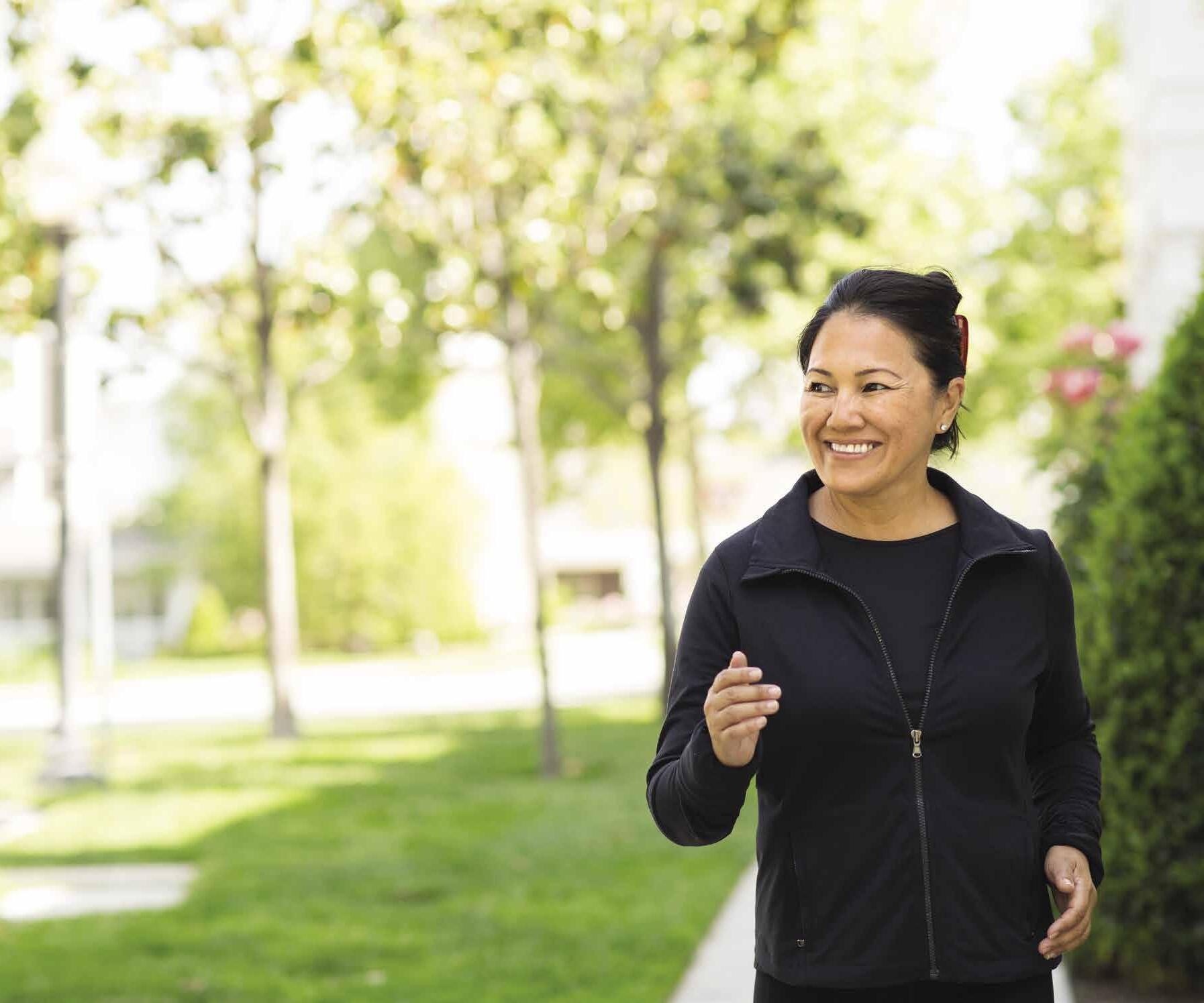

Stay on top of your health. Get a mammogram.
Routine screenings and timely appointments are essential to maintaining breast health, preventing disease and receiving early diagnosis and treatment. So when it’s time for your annual mammogram, turn to the Overlake Breast Health Center, offering the highest level of safety, comfort, clarity and convenience.
Schedule your next screening at Overlake.
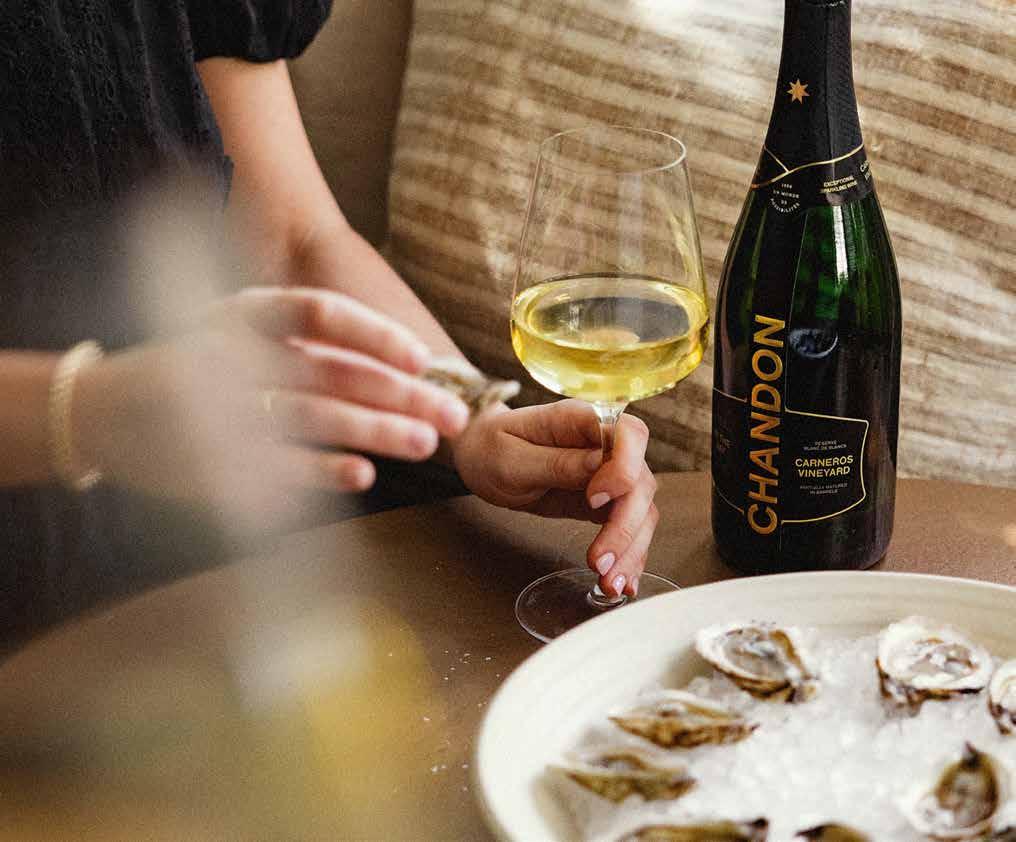
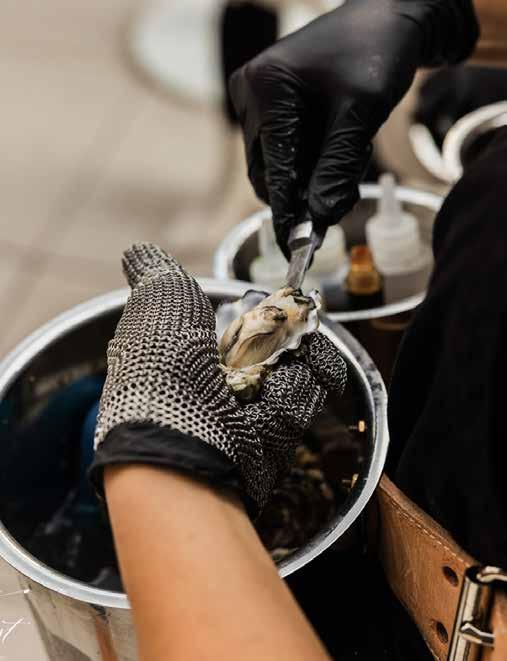
Sometimes what you really want for Mother’s Day is a child-free evening filled with oysters and sparkling wine. We’ve got you covered this year with mobile oyster caterer, SEAShucked, and bubbles from Chandon. Bring your mom and your mom friends along to celebrate each other. You deserve it. Friday, May 9 from 6-8 p.m. $50/per member, 21+
Karate is a full-body workout that enhances strength, flexibility and endurance. It improves cardiovascular health, balance and agility while burning calories and toning muscles. Plus, it improves focus and concentration. Join a class at the Club and learn from the best, Sensei James Penor, who has over 50 years of experience and is a 7th degree blackbelt. Classes available each session.
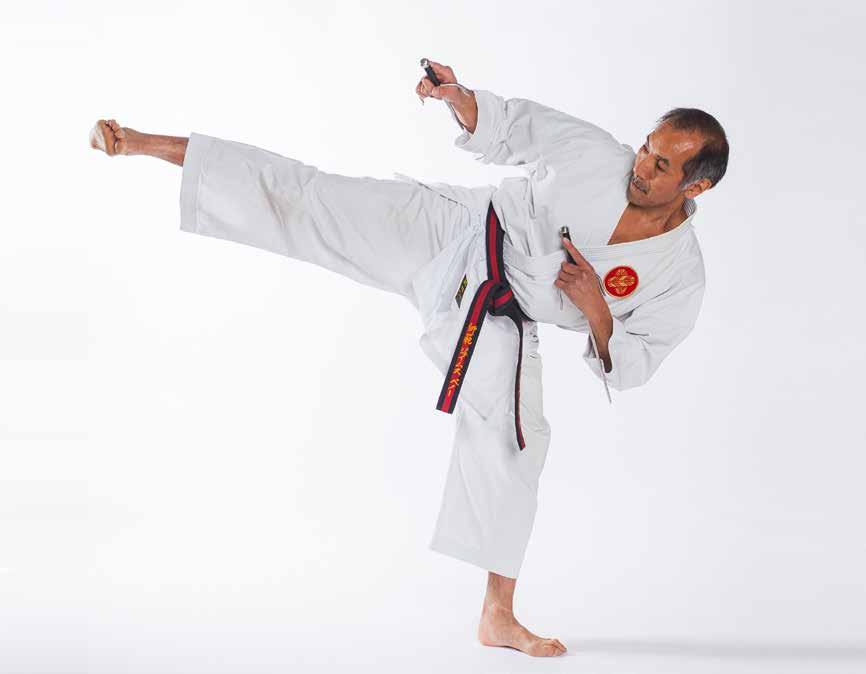






FLOWER POWER
Mary Carpenter, a Yakima-based artist and owner of Give Paper Flora (givepaperflora.com), is inspired by the vibrance and beauty of the natural world. One look at the paper flowers she creates out of heirloom-quality Italian crepe paper will brighten your mood and have you asking yourself who in your life would appreciate a blossom or bouquet of these joyful creations. Detailed and elegant, the flowers are deceptively easy to make. See for yourself on May 15 or June 12, 6-8 p.m., when Mary alights upon the Club with all the supplies you need to make one flower, plus detailed instructions and a kit to make one more at home. $100/member.
All classes occur on Thursdays in Cosmos or Polaris.
PUBLISH YOUR PASSION
May 1, 12:30-2:30 p.m. –
PAPER PEONY WORKSHOP
May 15, 6-8 p.m. –
SECRETS OF A SUCCESSFUL BOOK PROPOSAL
June 5, 12:30-2 p.m. –
PAPER FLOWER WORKSHOP
June 12, 6-8 p.m. –
PUBLISH YOUR PASSION
Seattle-based publishing pro Jen Worick (jenworick.com), is a New York Times best-selling author, editor, consultant and former publisher of Sasquatch Books. She'll be joining us on two occasions to reveal everything you need to know (or didn’t know you need to know) about getting your book project published today.
If you have a book idea, Publish Your Passion (May 1, 12:30–2:30 p.m.) is the place to discuss its viability and how to refine it. Jen will delve into what factors contribute to a book’s commercial success, how AI can help you in your research, and how to promote yourself and the book before it’s published.
Ready for the next step? In Secrets of a Successful Book Proposal (June 5, 12:30–2 p.m.), Jen will walk you through the ins and outs of creating a stellar book proposal that gets the attention of agents and editors. You’ll leave the class with an excellent road map for your proposal, including a template, marketing tips and how to suss out your competition.

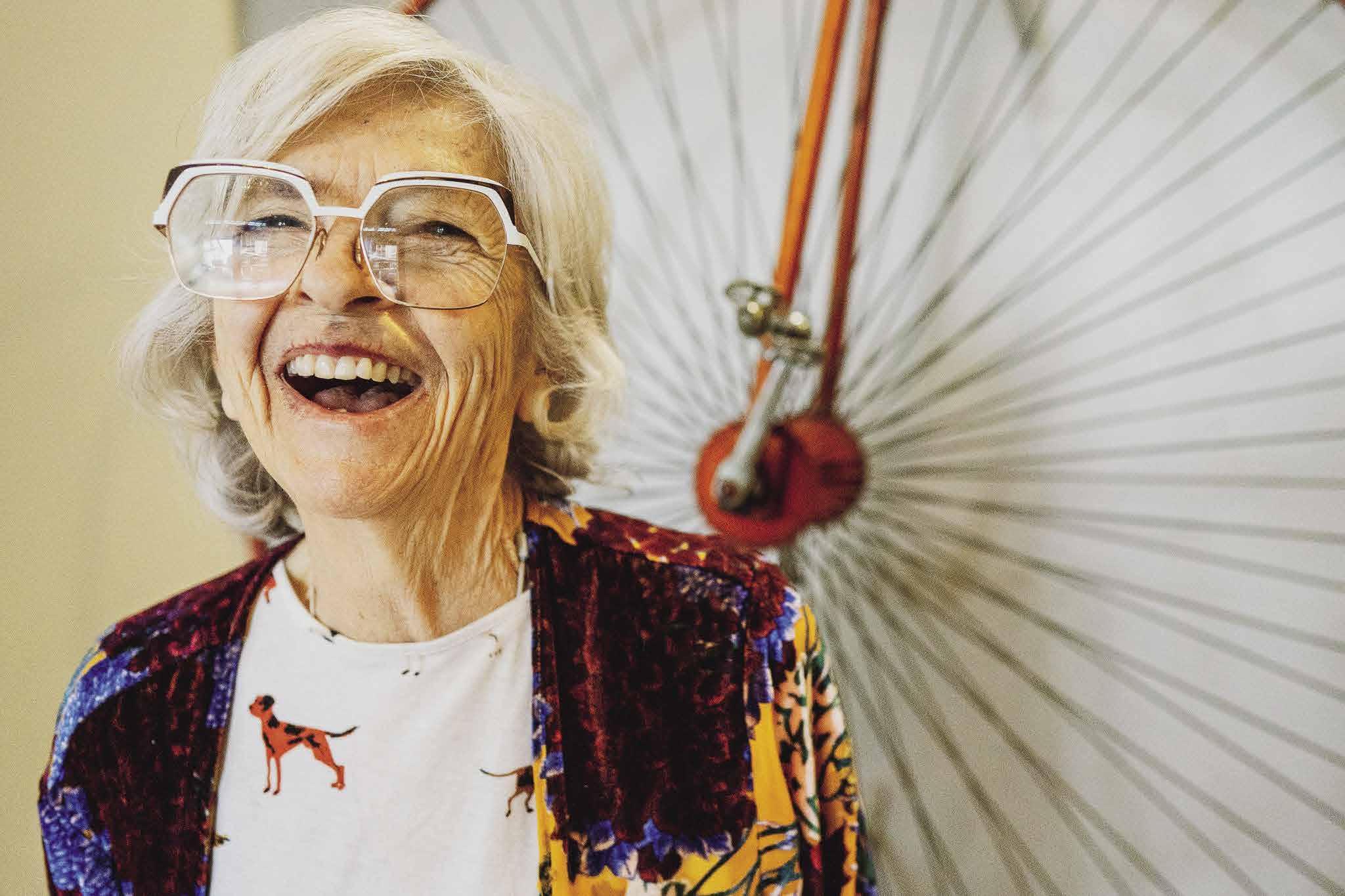
Whether you prefer a serene urban oasis with a stunning solarium or the walkable charm of Old Bellevue near boutiques and Downtown Park, find your perfect home at our two Bellevue communities. Each offers its own unique personality while delivering the exceptional care, service, and lifestyle that defines Aegis Living We'd love to show you around!


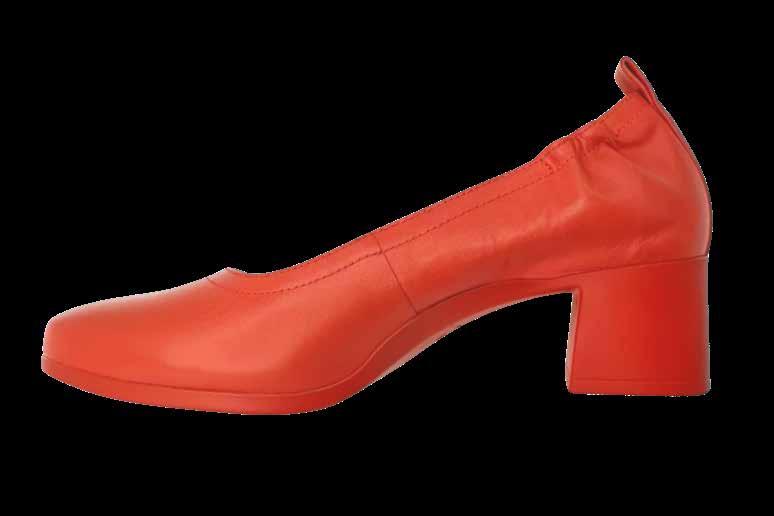
“Women have faced an absurd choice for too long: endure painful heels or compromise on style,” says Caroline. “I was ready to give up on heels altogether—the pain wasn’t worth it.” But Caroline’s no quitter, so she took it upon herself to remake the type of chic dress heels she longed to wear from the ground up. In 2024, after five years of collaborating with biomechanics experts and designers across four countries, The Performance Heel by PIAR was born.

Club member and Ironman triathlete
Caroline Hughes delivers a comfortable shoe that doesn’t skimp on style.
Caroline Hughes knows a thing or two about the importance of proper footwear. After years of intense endurance training, the only shoes that her feet could endure were running shoes and Dansko clogs—neither of which really cut it in the fashion department.

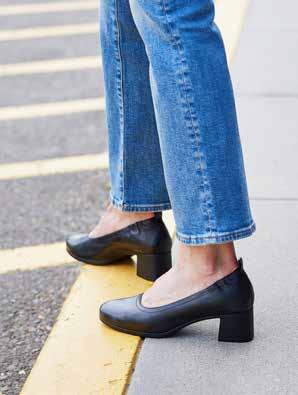
To begin with, Caroline wanted something rarely (if ever) seen on the market: a comfortable ballet-inspired block heel that featured more than merely a cushioned footbed. To achieve this unicorn of footwear, the two-inch heel would be reengineered with performance tech from athletic shoes, enhancing stability and shock absorption to provide long-lasting support. Additionally, the shoe’s supple toe box can be stretched to accommodate bunions or other podiatric challenges. These would be shoes that even the most intrepid traveler or active woman could happily don for days. PIAR’s first collection comes in
versatile black and vibrant lava-red Nappa leather handcrafted by a family-owned factory in Brazil. These are wear-everywhere-with-everything shoes that absolutely go the distance. “PIAR is really about more than heels,” Caroline explains. “It’s about helping women feel comfortable, confident and unstoppable.”
➔ PIAR shoes, $195, come in whole and half sizes between 6 and 12 at hellopiar.com. Keep an eye out for more colors coming soon. Want to try before you buy? Caroline will be popping up with her shoes at Carmilias (4528 California Ave SW in West Seattle) on May 10.







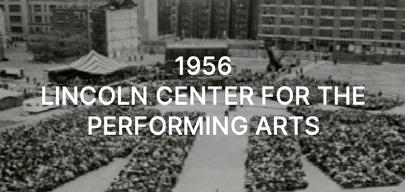

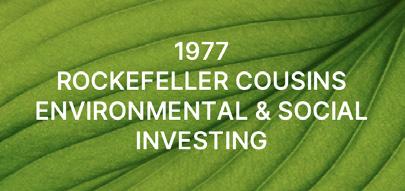


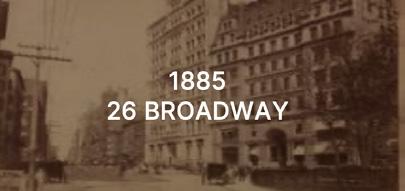




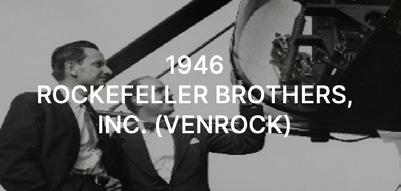




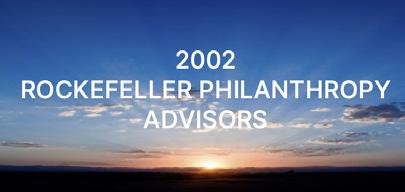
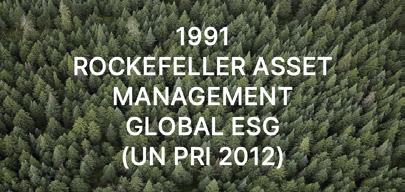
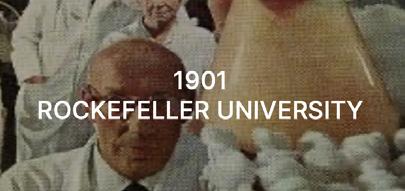

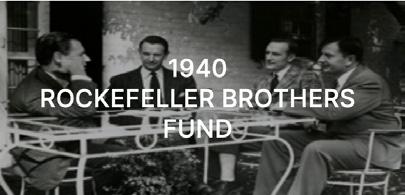



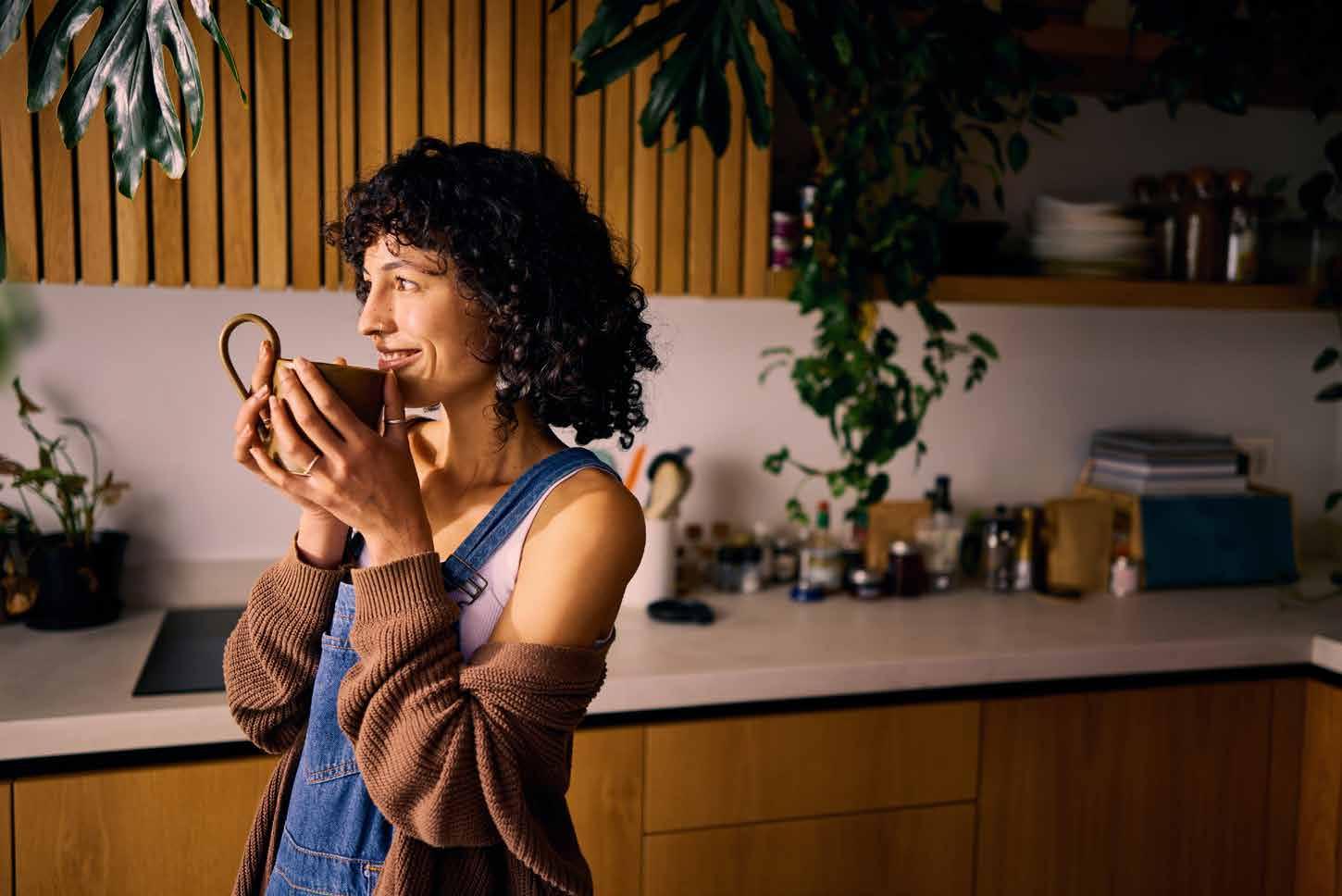
written by lauren manaker
The poor, beleaguered metabolism is often a scapegoat for weight gain and low energy. Blaming the metabolism for everything is an oversimplification, of course, and disregards many other factors that affect weight and energy levels. It also implies we have more control over metabolism than we do. In fact, the metabolism is primarily influenced by genetics, age and body composition—things very much out of our control. Luckily, there are some sensible healthy habits you can adopt to help your metabolism function in fine form.
Metabolism is the process your body undergoes to convert food and drink into fuel for the body. You’re doing it constantly on the cellular level to maintain homeostasis, whether you’re awake or asleep. The energy required to keep your body going while at rest is your basal metabolic rate (BMR). People with a high BMR burn more calories when at rest, which means they’ll need more calories to maintain their weight. Conversely, a person with a slow BMR burns less calories at rest and needs less calories to maintain their weight. Regardless of how fast or slow your BMR is, the calorie in/ calorie out equation is key to the weight we lose and gain throughout our lifetime.
Physical activity is one of the most effective ways to naturally support a healthy metabolism. Exercise increases the number of calories your body burns, even when you’re at rest. Strength training, for example, builds muscle, which is metabolically active tissue. The more muscle mass you have, the more calories your body uses to sustain it. Alongside strength training, incorporating cardio activities like walking, running or cycling helps increase your overall energy expenditure and supports heart health. A mix of both strength and endurance exercises is ideal for optimizing your metabolic rate.

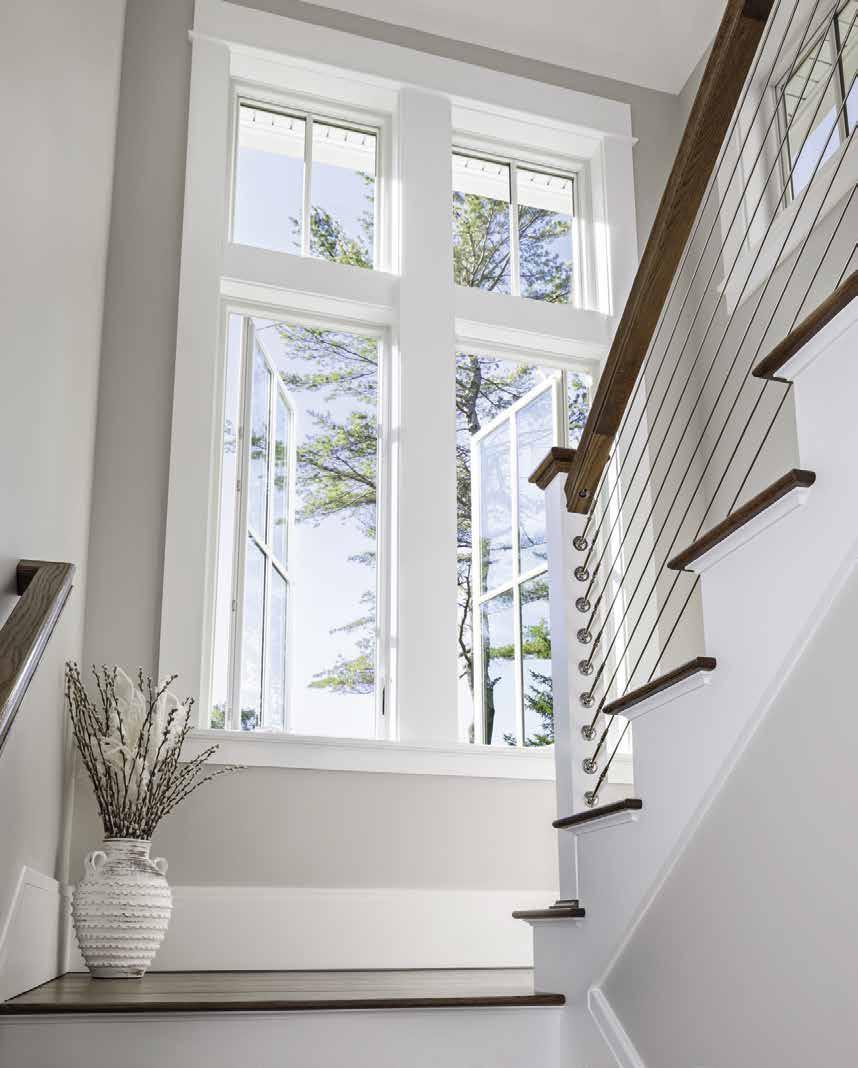


Eating enough protein is essential for several reasons, particularly when it comes to digestion and metabolism. Protein has a higher thermic effect of food (TEF) compared to carbohydrates and fats, meaning your body uses more energy to digest it. Including a source of lean protein at each meal—chicken, fish, eggs, beans or tofu—will keep you full longer and your energy steady.
Eating balanced meals at regular intervals helps maintain steady blood sugar levels and reduces the likelihood of overeating. Focus on whole, nutrient-dense foods like fruits, vegetables, whole grains, nuts and lean protein. These foods provide the essential vitamins and minerals your body needs to run smoothly without causing energy spikes or crashes.
Drinking enough water each day is a simple but vital way to support a healthy metabolism. Dehydration can slow down metabolic processes, making it harder for your body to convert food into energy effectively. Adding a glass of cold water before meals may also help with appetite regulation and provide a slight metabolic boost as your body uses energy to bring it to body temperature.
Sleep is often overlooked when discussing metabolism, but a lack of it plays a role in regulating the hormones leptin and ghrelin, which influence hunger, energy levels and fat storage. Over time, sleep deprivation can lead to a slower metabolic rate and increased cravings for unhealthy foods. Aim for seven to nine hours of quality sleep per night and establish a consistent bedtime routine.
Chronic stress can negatively affect your metabolism by causing an increase in cortisol. High cortisol levels can lead to increased appetite and promote fat storage, particularly in the abdominal area. Incorporate meditation, yoga or deep breathing into your day and try to get outside: many in-depth studies have shown that spending time in nature combats stress in myriad ways.
Supporting a healthy metabolism is about adopting a balanced, consistent approach to overall health. Patience and consistency are key—no single habit or food will transform your metabolism overnight. Focus on a holistic and sustainable approach to make positive changes that have staying power.



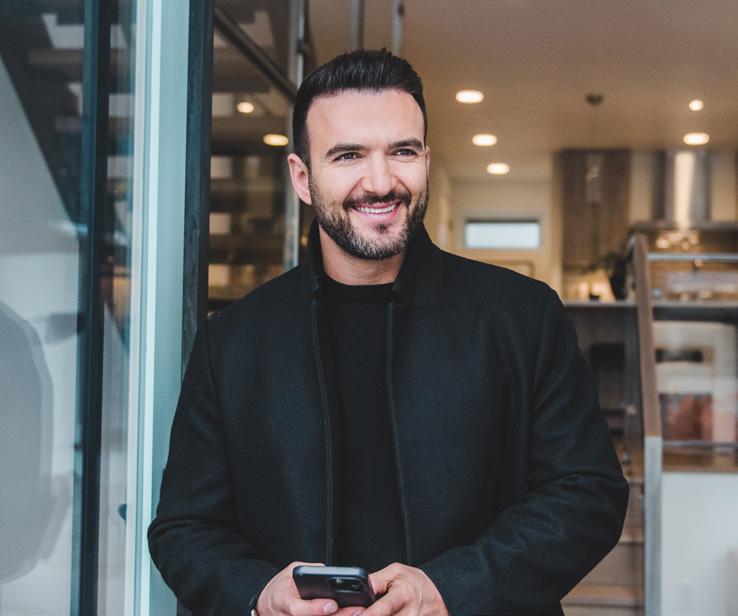



Head to Eclipse this spring, where performance wear meets the perfect putt.
Among the men's lines carried in the boutique, Bogner’s golf line is always above par. It blends performance quality fabrics with quick-drying technology for function along with cool details and colors for form—a fashion double eagle and a stroke of style genius.
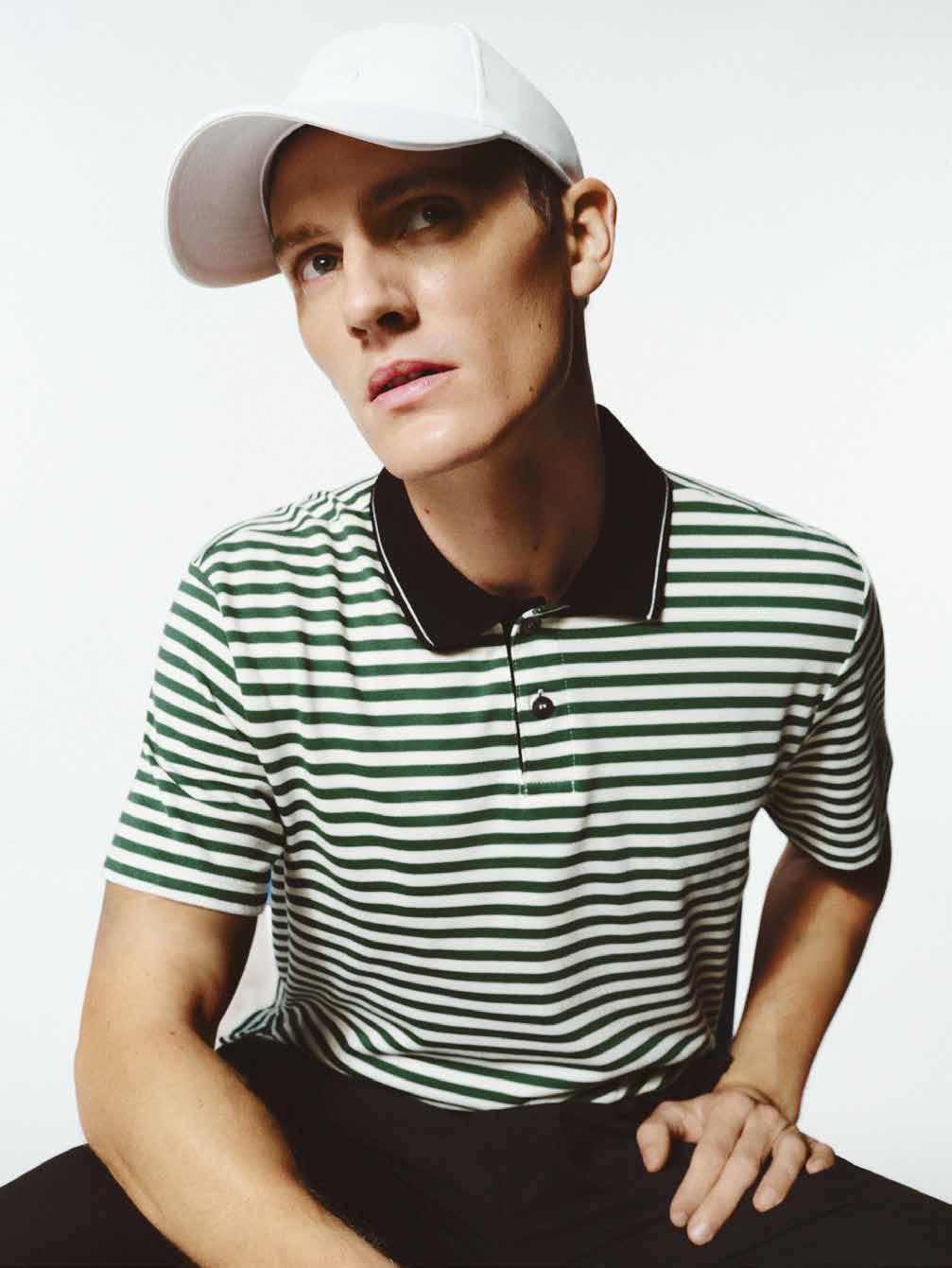

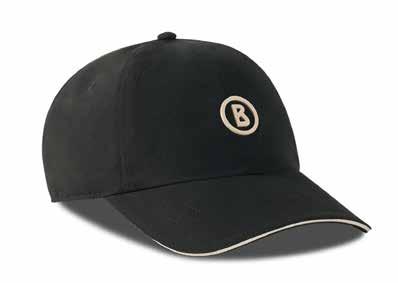
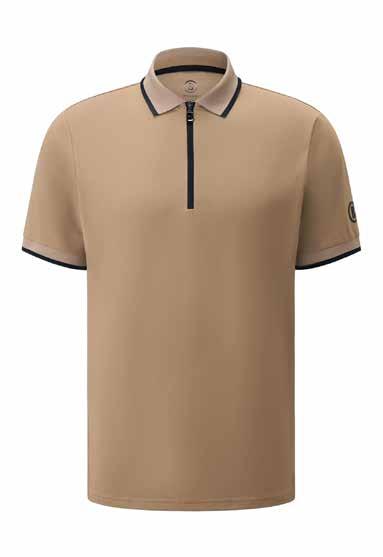
A fore-ever stylish top crafted from the finest blend of wool and silk for all-weather wear. An easy, breezy vest with quilted padding made with recycled nylon and duck down. The cutest cotton sweater that says it all. And a smart shirt in a vibrant pink for maximum flair. It’s style that’s always in full swing. Get ready to
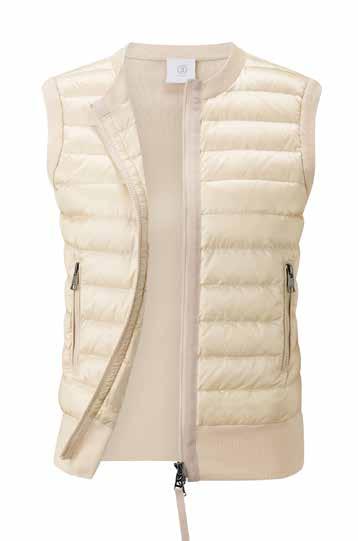


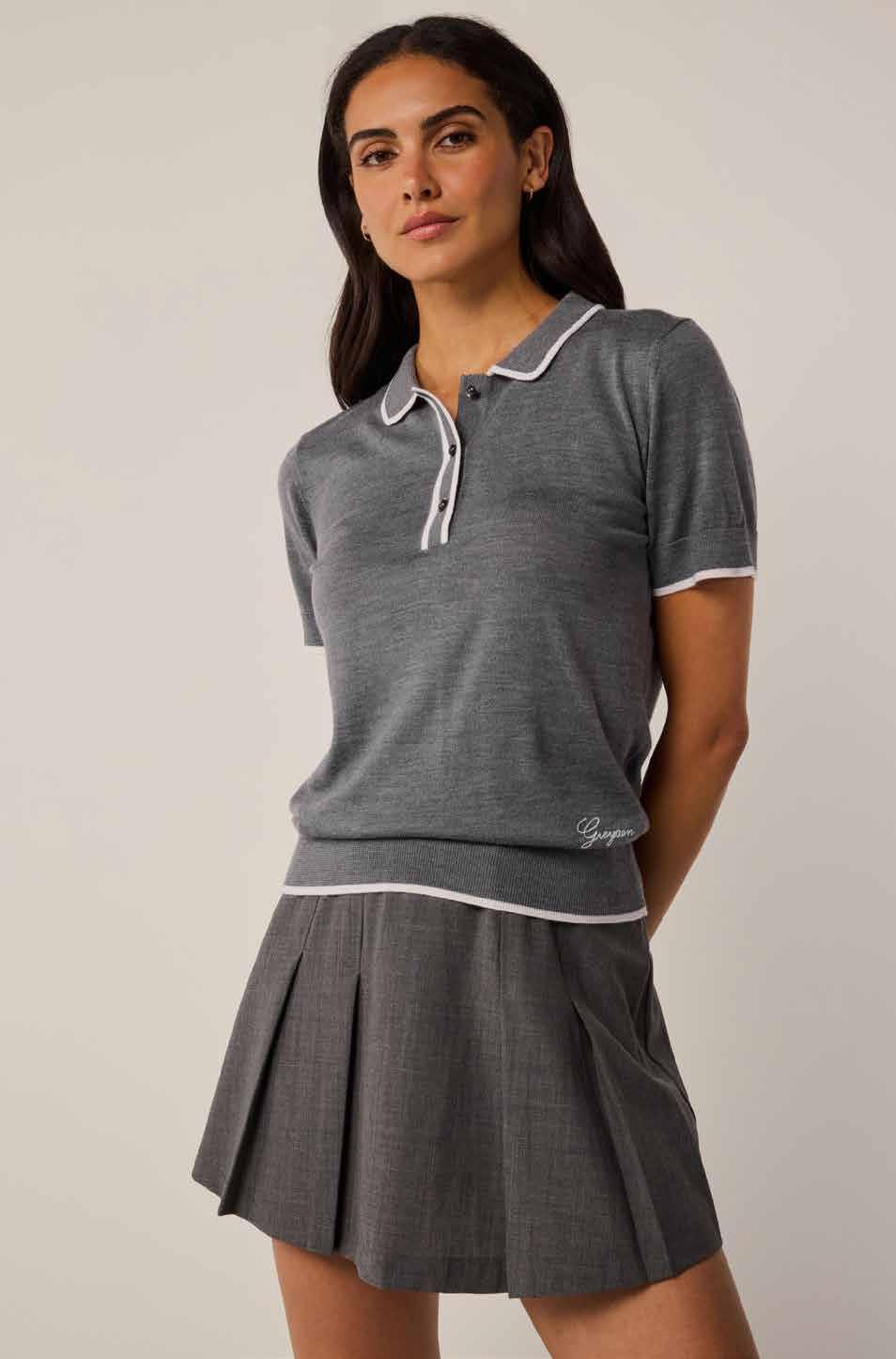






We sat down for a Q&A with orthopedic surgeon Dr. Samuel Galle to get to the crux of this common ailment.
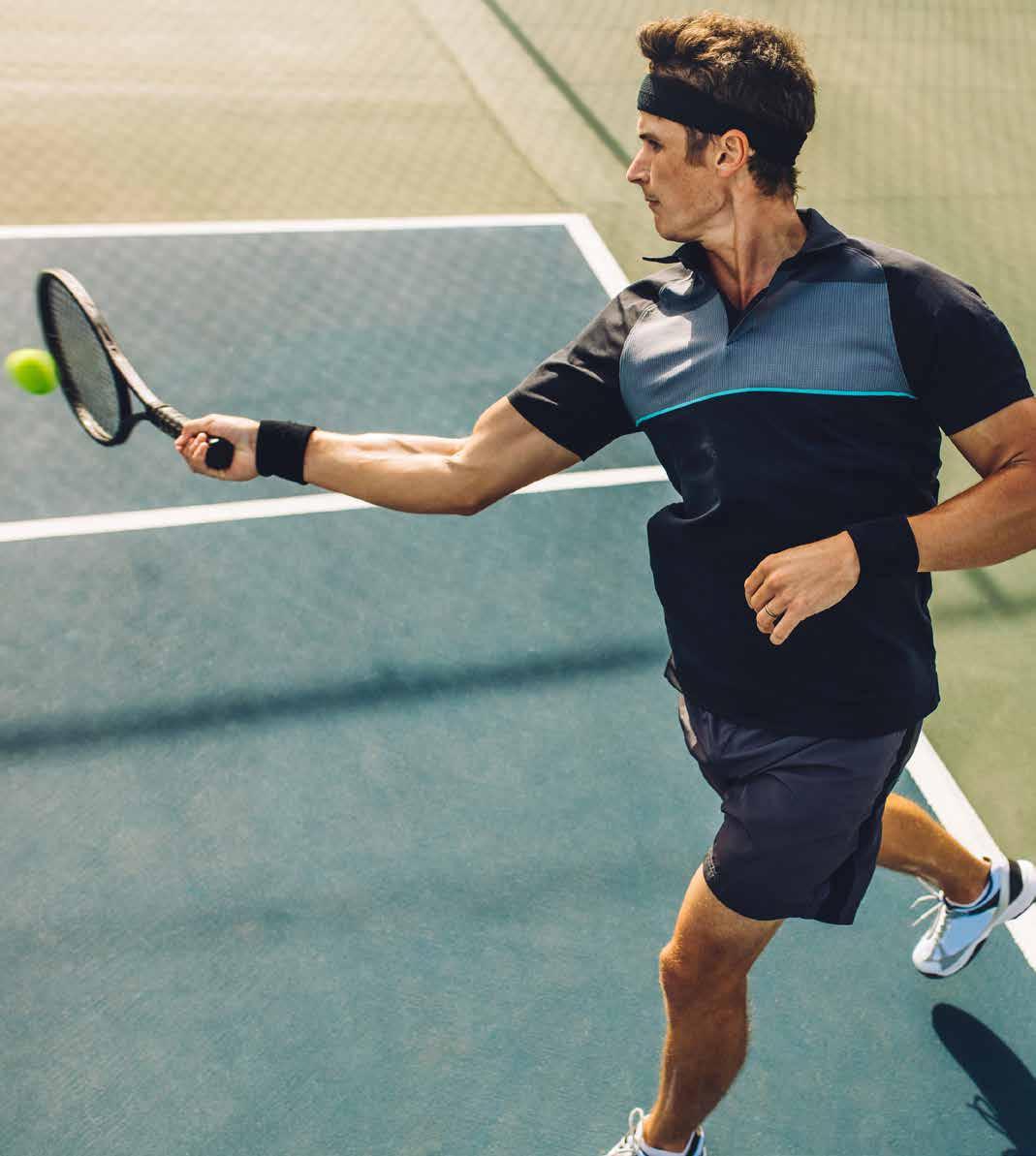
Tennis elbow, or lateral epicondylitis, is a problem with an elbow tendon and a frequent cause of adult elbow pain along the outside of the arm. It is often described as a nagging elbow pain when lifting even light objects such as a coffee cup. And while the name implies inflammation, it’s now understood to be a degenerative condition of one elbow extensor tendon.
Tennis elbow is commonly thought to be an overuse condition of the elbow, but this is heavily debated within the medical community. Some patients present with a bout of tennis elbow after gardening for 12 hours straight, and just as often patients will describe the pain slowly worsening over time without any specific provoking event. There does not seem to be just one way to get this problem, which adds to the complexity of treating it. Almost certainly there are activities that we do daily with poor ergonomics that contribute to the eventual full-blown pain of tennis elbow.
Tennis elbow is a clinical diagnosis, which means that your physician can perform a physical examination to confirm the condition. This is oftentimes without the use of X-rays or advanced imaging, but some providers will perform an ultrasound examination of the elbow to confirm tendon changes.
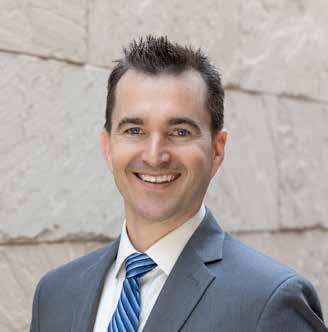
Dr. Samuel Galle is an orthopedic surgeon at Proliance Surgeons with a clinical focus on hand, wrist and upper extremity surgery. He pursued his medical degree and orthopedic surgery residency at the University of California, Irvine School of Medicine and specialized in hand and upper extremity surgery at Columbia University in New York City.
His approach is a combination of patient-focused care, lifelong learning and a comprehensive team approach from injury to recovery. In addition to treating patients at Proliance, he is an active physician with Overlake Medical Center, Swedish Health Services in Issaquah and Evergreen Health Medical Center.
He lives in Bellevue with his wife, Gianna, and two children, Elizabeth and Alexander. When not at work, he enjoys playing soccer in the Greater Seattle Soccer League, skiing with the family and wakesurfing on Lake Washington.
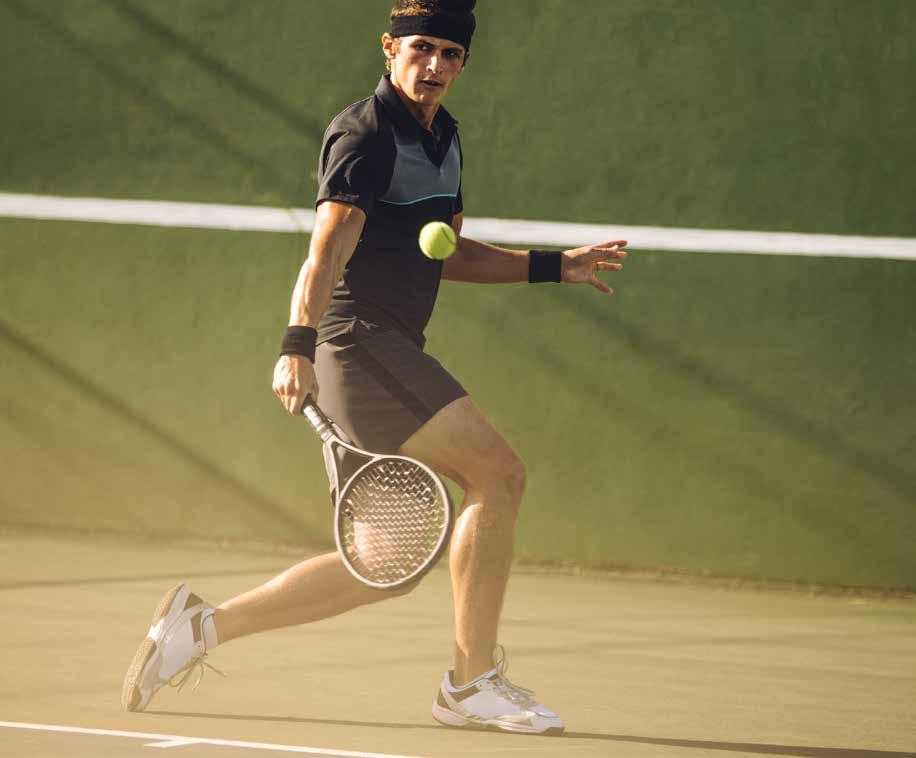
Tennis elbow commonly responds to conservative management—one study showed nine out of 10 patients improve at one year with this alone. The mainstay of this treatment is a course of therapy with a certified hand and upper extremity therapist aimed at restoring balance and strength to the entire arm or kinetic chain. This can include ergonomic evaluation, myofascial release, radial nerve glides (exercises that help to relieve mobility and pain in the radial nerve) and strengthening of the arm. Other conservative options include rest, activity modification, medications, braces and injections, such as steroids. Surgery is a more aggressive option, but most surgeons recommend months of conservative management prior to surgery given the number of people that improve without making an incision.
Unfortunately, tennis elbow is a condition measured in months and years rather than days. A conservative therapy program usually takes a few months, particularly when patients start in such a painful state that immobilization is the starting point.
Each case is different just as each patient is different, and so identifying the contributing factors is key to preventing significant return of symptoms. If we can educate the patient and correctly identify the poor ergonomics that contribute to this condition, then we can likely effect change. Certain postures can be improved, and others can be eliminated to the best of our ability.
Unfortunately, there is no easy answer to this question. Some physicians argue that it is part of the human condition because it is relatively commonplace. Personally, I caused my own tennis elbow to flare by dragging a too-heavy suitcase through the airport for hours while waiting for a flight. My anecdotal suggestion to avoid getting tennis elbow would be to refrain from doing that!
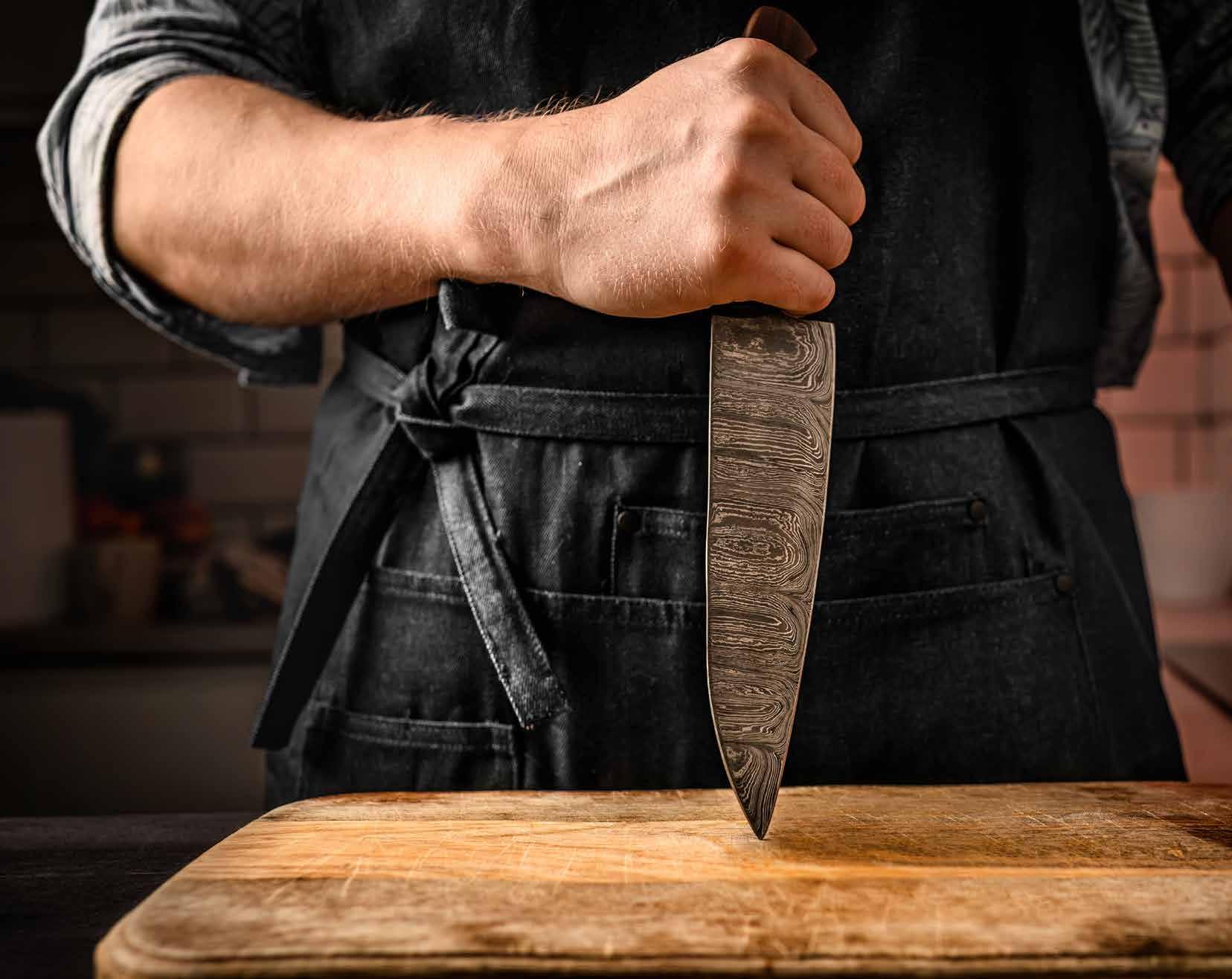
A good sharp knife is a cornerstone of a well-equipped kitchen, and often the culinary tool most neglected by the home cook. How many times have you lamented the dullness of your knives while using them, only to put them back in the block, forgetting your vow to have them sharpened? Probably every time. Until now. Here’s a handy reference guide for keeping your knives in perfect working order and a chance to have them sharpened by a pro simply by dropping them off at the Club.
written by alison brownrigg
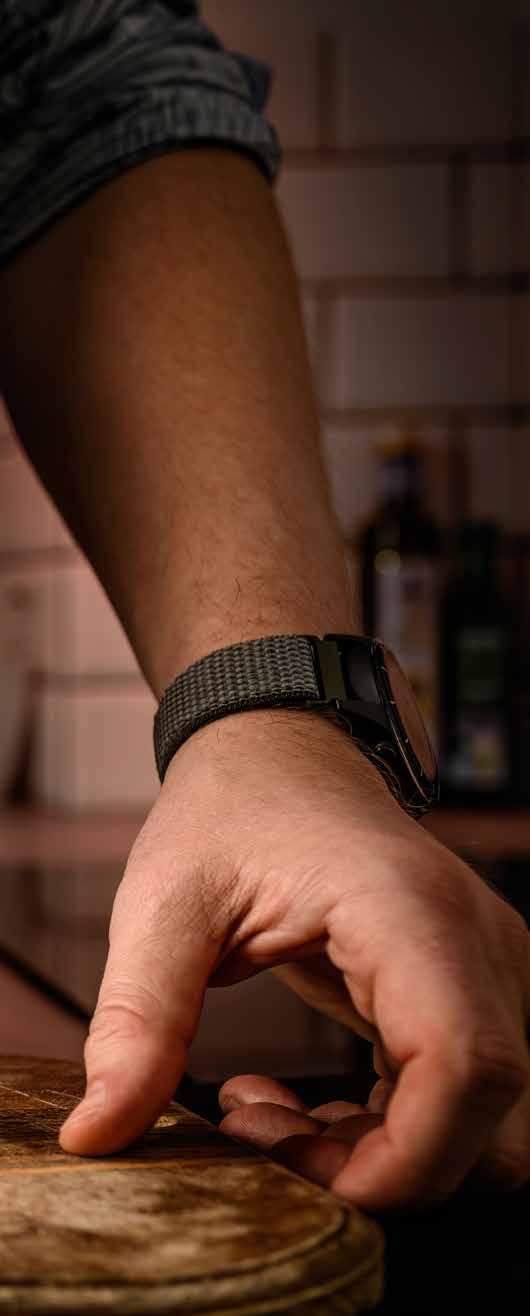
There are two key components to proper knife maintenance: honing and sharpening. According to professional knife sharpener and former chef Darin Gagner of Valley Sharp (valleysharp.com), honing ideally happens frequently and sharpening only when necessary. “The edge of a knife made of quality steel is robust but goes out of alignment and eventually rolls over. Honing a knife corrects the edge and keeps it working between sharpenings.”
Honing a knife entails using a leather strop or ceramic rod (also called a steel) to realign the edge of the knife. If you’ve ever watched a cooking show on TV, you’ve likely seen a chef honing a knife before beginning to cut with it. Sharpening, which requires a whetstone or a professional’s touch, remakes the edge. Unless you’re an overzealous knife user, you’ll only need your knives sharpened once or twice a year.
While we are all taught to be careful when handling a sharp knife, it’s a dull knife we should be wary of. “The duller the knife, the more force is needed to complete a cut, and the more it will slip in use,” explains Darin. “This makes a knife dangerous. A sharp knife stays on target and requires little more than the weight of the knife to complete a cut.”
A common misconception is that sharpening a knife removes a lot of material from the blade. Not so, says Darin. “What really eats away at the edge of a knife is damage and chipping from misuse.” Just like other tools you may use in your daily life, different knives are used for different purposes. A standard chef’s knife isn’t crafted to cut through bone like a cleaver, it’s meant for slicing, chopping and mincing. Misusing a knife for something other than its intended purpose will result in chips and damage that will shorten the lifespan of the knife.
Darin recommends MAC, Miyabi and Victorinox brand knives for good value versus performance. “If you are going to invest in a good knife, hold it in-person,” he says, “and buy from a shop that also sharpens.” Reliable stores near Bellevue include Seattle Edge in Ballard (2607 NW Market Street, 206-799-0412, knifesharpeningseattle.com) and Seattle Cutlery in Pike Place Market (1920 Pike Place, 206-441-8988, seacut.com). “The experts at these shops can talk to you about what you cook, how you cook and what you’re looking for,” he continues. “It’s worth the extra money to find the right knife and have an expert to answer your questions. You can’t get that kind of experience online.”
OTHER CONSIDERATIONS FOR PROPER KNIFE CARE:
• Do not put your knives in the dishwasher.
• Use a citric-acid-free dish soap like Dawn to clean your knives.
• Dry them completely after use.
• Bamboo is too hard a wood for use as a cutting board. Use an end grain butcher block made from maple, walnut or cherry for cutting veggies and thick plastic ones for cutting meat.
• Store your knives on a magnetic strip covered by wood or another material, not only because it’s better for the knife but because it looks cool on your kitchen wall.
Darin from Valley Sharp will be at the Club on June 10 and 11 from 10 a.m. to 4 p.m.
Members will be able to drop off their knives, including kitchen shears and serrated knives, and pick them up the next day. The cost for each knife is $15, and Darin can repair tips, chips and damage in addition to sharpening. Reservations are required.
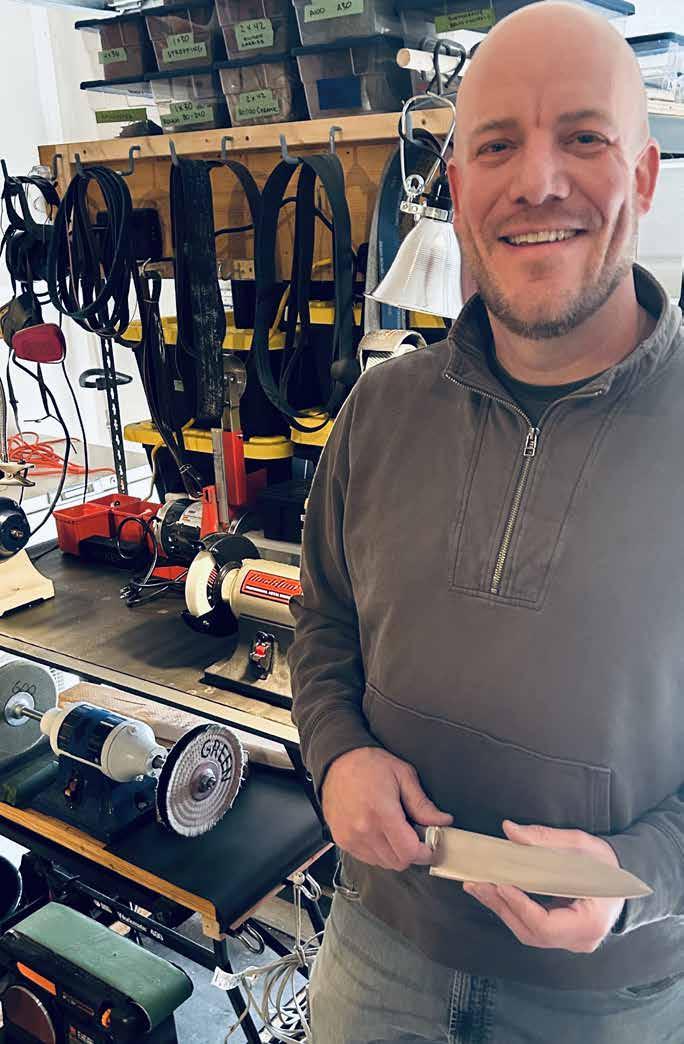
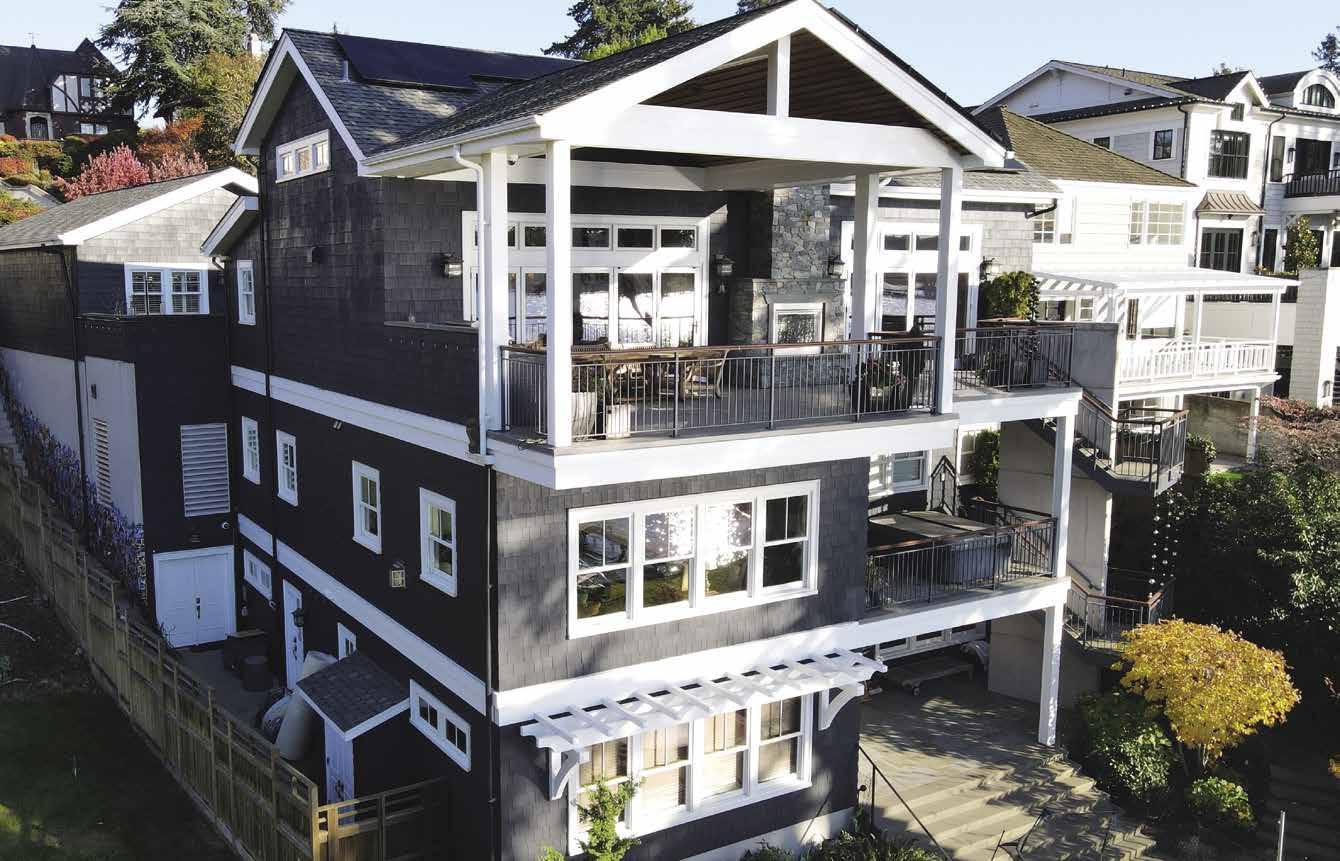
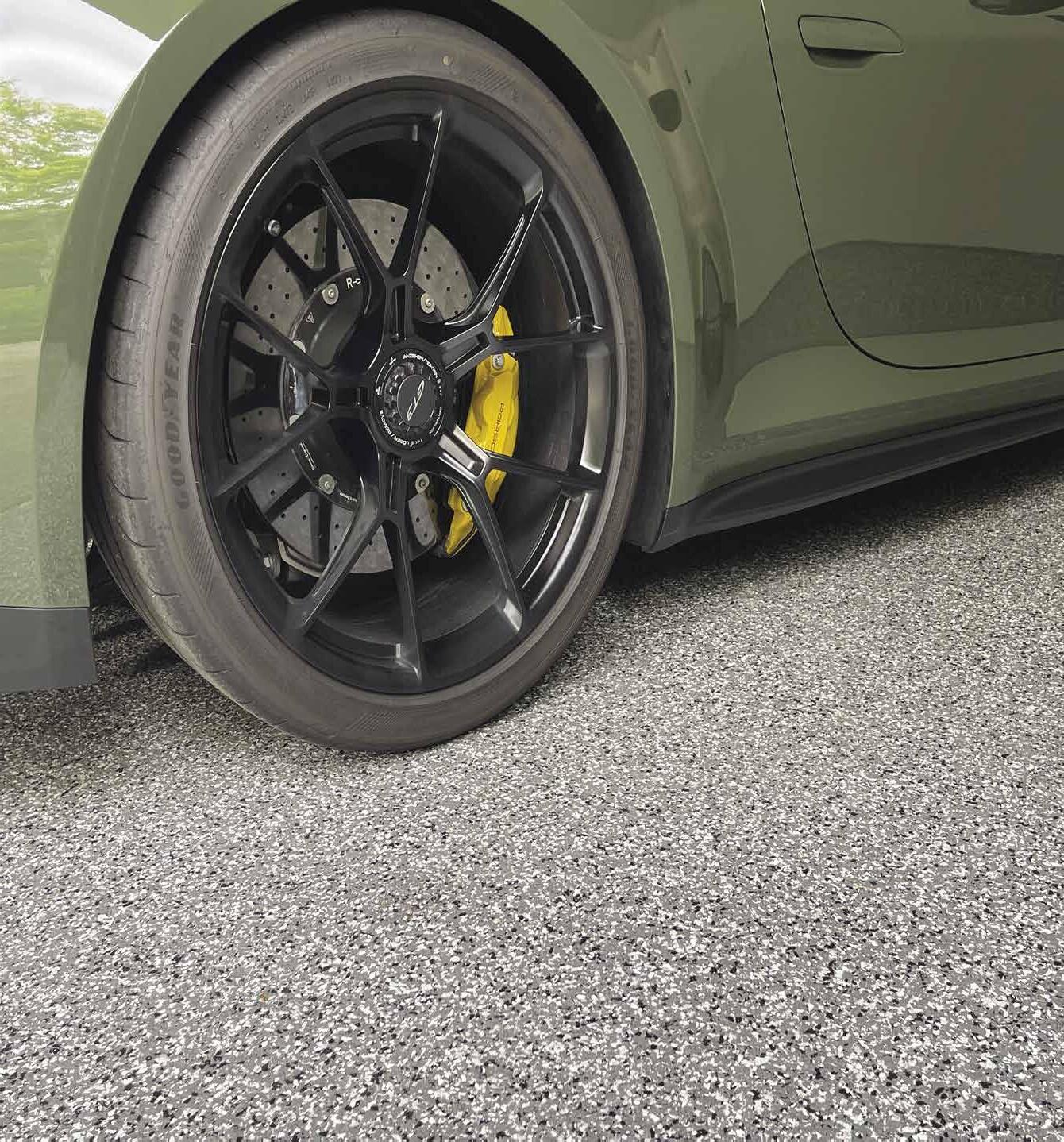

Women have lower rates of heart attacks than men until they reach menopause, when their risk of a heart attack climbs rapidly. In fact, heart disease is the number one killer of postmenopausal women, more than all cancers combined. If you’re a woman of a certain age, understanding how menopause and estrogen levels affect your heart might just be a lifesaver.
Estrogen plays a vital role in cardiovascular health in several ways. It promotes the production of good cholesterol (HDL) and suppresses the production of bad cholesterol (LDL); it protects the lining of the arteries by acting as an anti-inflammatory; it relaxes the muscles around the arteries to improve blood flow; it improves insulin sensitivity and regulates blood sugar. These actions slow the development of hardening of the arteries, which leads to heart attack and strokes.
As women go through menopause, their estrogen level drops dramatically and with it those protective effects. The earlier in life a woman stops producing estrogen, the higher her risk of cardiovascular disease. Women who go through premature menopause or have their ovaries removed before age 40 have a substantially higher risk of heart disease.
Additionally, studies have shown that women who have severe hot flashes have higher rates of cardiovascular disease. It’s unclear why hot flashes specifically increase cardiac risk, but one factor is how disruptive they can be to sleep. Poor sleep quality in general increases the risk for cardiovascular disease.
Other major risk factors for heart disease include smoking, stress, lack of physical exercise and other unhealthy lifestyle choices.
The next logical question is whether taking an estrogen replacement will help prevent heart attacks. The current guidelines for hormone replacement therapy state that estrogen should not be prescribed to prevent heart disease. The only large-scale randomized study on this topic from the Women’s Health Initiative (WHI) did not show a heart benefit from hormone replacement therapy.
However, many observational studies assessing millions of women have shown that estrogen replacement therapy can lessen the risk of developing a heart attack.
There is controversy over whether today’s treatment recommendations should be based on the WHI study. In a nutshell, the study is 23 years old, the hormones used were not bioidentical (which are the kind we recommend today) and the average age of the women in the study was 63—much older than the average age women enter menopause.
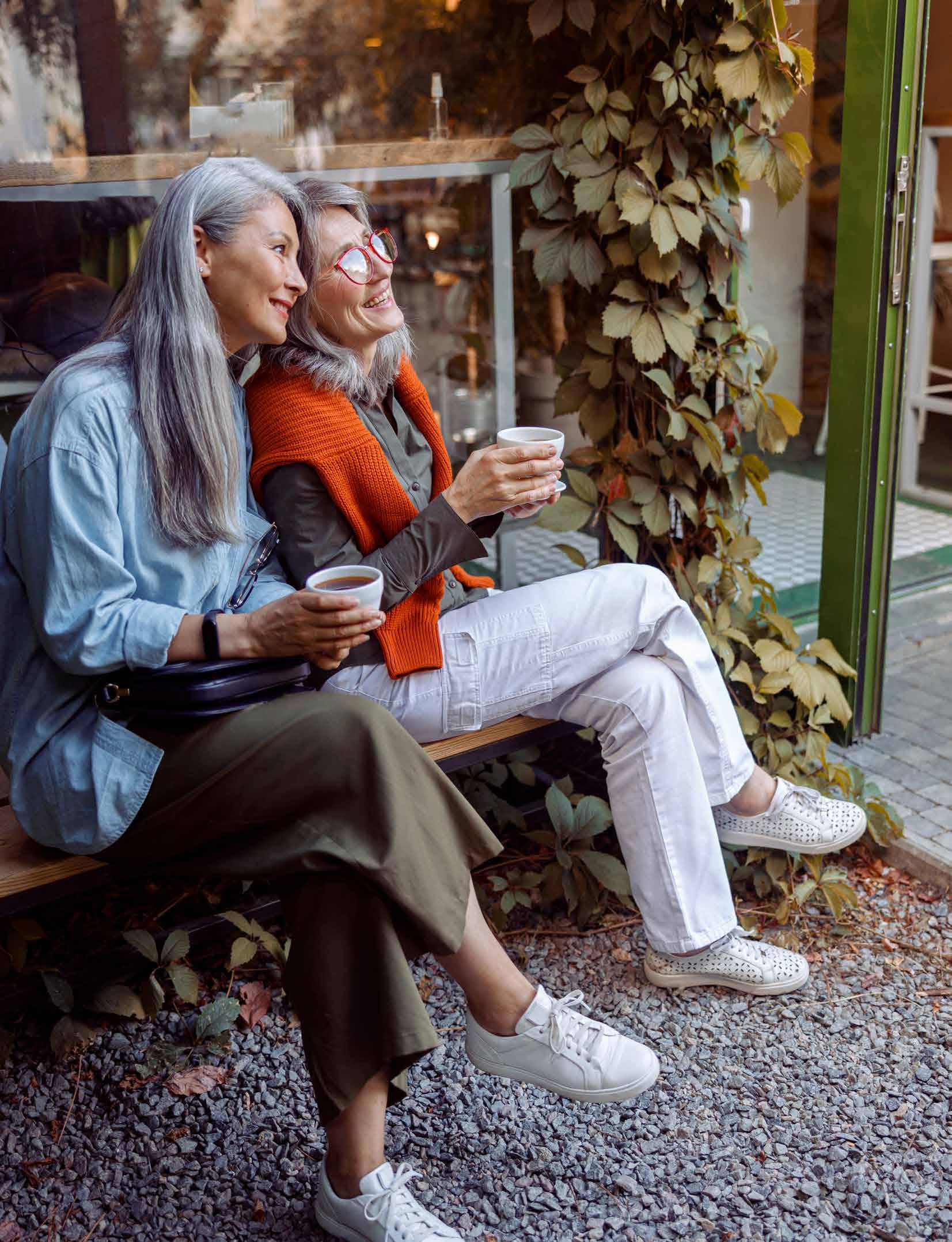

is a board-certified internal medicine specialist with over 40 years of experience taking care of women in menopause and beyond. She is the author of “The Estrogen Question: Know Before You Say ‘No’ to HRT,” written to educate women about the benefits and risks of hormone replacement therapy. When not reading or writing about menopause, she can be found in one of the exercise rooms or on the tennis courts at the Club or tending to her 80 rosebushes.
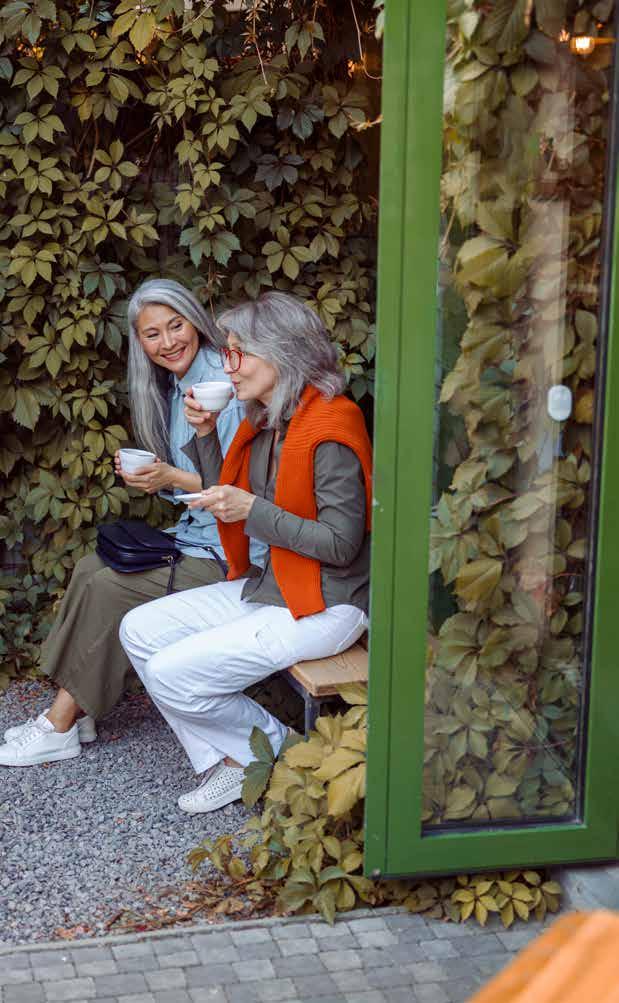
Symptoms of heart disease in women can be different than what men experience. Rather than chest pain, women may have more subtle symptoms such as nausea, shortness of breath or fatigue. Even if a woman has more typical symptoms, such as chest pain on exertion, the tests commonly used for men may not be positive in women. The standard tests focus on blockages in the major arteries, whereas women frequently have what is called microvascular heart disease, blockages of the very small blood vessels, which don’t show up on those tests. As a result, heart disease can be missed in women.
Women need to educate themselves about the benefits and risks of estrogen replacement and cardiovascular health and have an informed discussion with their health-care providers. Besides potential heart benefits, estrogen replacement is the most effective treatment for hot flashes and other menopausal symptoms such as vaginal thinning, mood swings and sleep problems. Estrogen prevents bone loss, which rapidly accelerates during menopause, and research shows it may protect brain function. Whether estrogen causes breast cancer remains controversial, but even so the risk is very low and must be balanced against the cardiac benefits. Women are 10 times more likely to die of heart disease than breast cancer but much more likely to be screened for breast cancer than for heart issues.
A woman going through menopause should have her cholesterol, blood pressure and blood sugar monitored and be open to making lifestyle changes or undergoing treatment if the values are high. A generally healthy woman may not need more in-depth testing, but if a woman has risk factors, she may benefit from a coronary calcium test, which is a rapid, low-dose CT scan that looks for early signs of plaque building up on the heart arteries.
As noted, a woman’s complaints may be dismissed if an initial evaluation does not suggest heart disease. In these cases, she should be proactive and advocate for further evaluation or a second opinion.



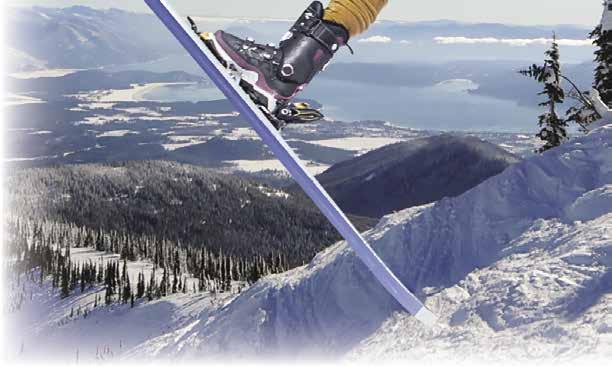
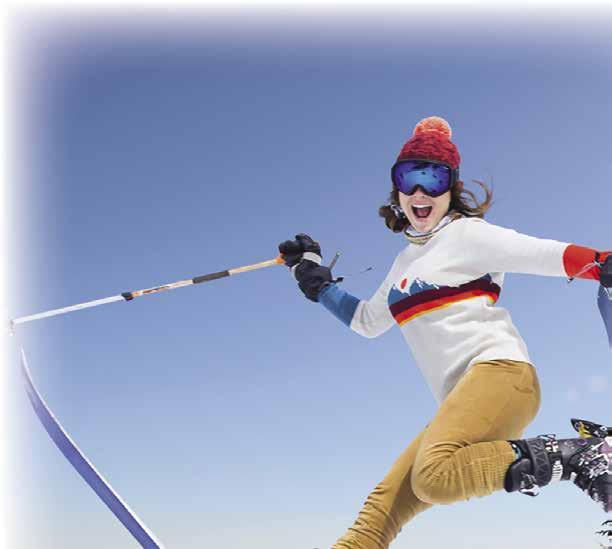

Set on Schweitzer resort’s highest, most coveted slopeside location, SMP Development’s Crystal View ski-in/ski-out view homesites reward you and your family with the most desirable skiing, biking and mountain lake recreation in the Pacific Northwest.
These extremely rare homesites showcase dramatic panoramas of our enormous neighbor, Lake Pend Oreille; Schweitzer ski trails; forested mountains; and the lively, lakeside town of Sandpoint, Idaho.
Create your unique four-season retreat, avoid the overcrowded and overdeveloped resorts, and discover Schweitzer before it’s discovered. For now and for generations.
208-812-7005 or crystalviewatschweitzer.com
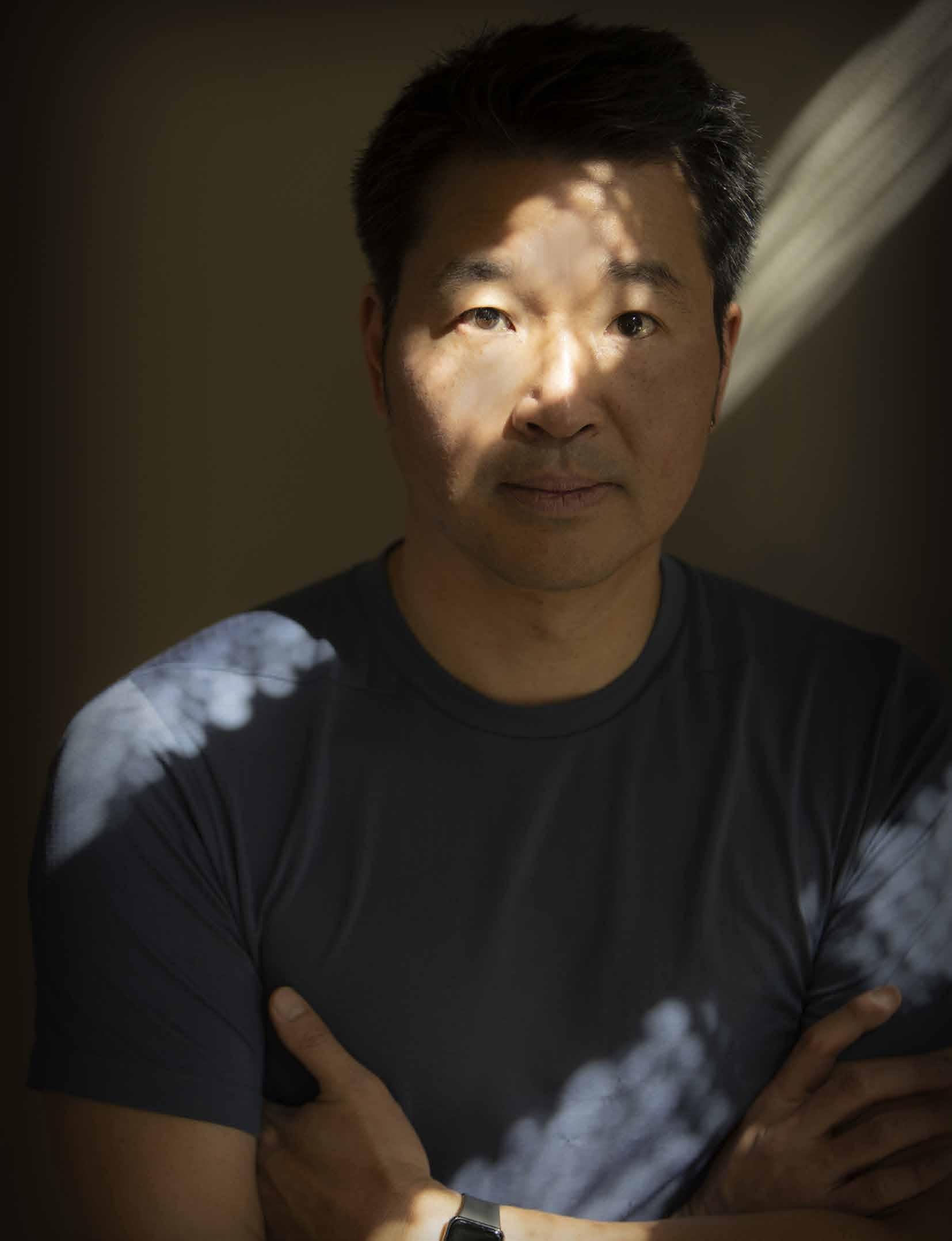
written by alison brownrigg photography by j. garner photography
JANUARY 11, 2025
started out as a normal Saturday for 47-year-old Jake Yoon as he and a group of buddies met at the Club for their regularly scheduled morning of basketball. Despite being a little tired from a recent business trip, Jake, a husband and father of two teenagers, felt fine. He paced himself throughout the first few games, then started to run a little faster after he felt warmed up. It was just a few plays into the next game that Jake suddenly couldn’t breathe. He had just enough time to tell his friends he needed a break before his vision went black and he collapsed.
JAKE WAS HAVING A HEART ATTACK.
What transpired next was a scary and confusing blur for Jake. “I was completely out, but it wasn’t painful,” he explains. “The first thing I remember was someone cutting my shirt and then I started hearing things, but I couldn’t understand anything,” he continues. Eventually Jake’s vision brightened, and while he was unable to speak or move, he began to understand the questions he was being asked. By that time, the paramedics were on the scene, and he was ready to be transported to Overlake Medical Center.
Luckily for Jake, a fortuitous series of events started to coalesce around him the minute he fell to the floor. Guest RYAN VALDES, a former firefighter, just happened to be queuing up for his next game of pickleball when he heard a loud bang coming from the basketball court. “I looked over and saw Jake lying on the ground, so I went over and found that he was unresponsive. I assessed his condition by checking his radial and carotid pulses, but, unfortunately, there were none present.” After attempting a few basic responsiveness checks, Ryan began CPR. Another member, nurse CONNIE GARVEY, who was also in the gym at the time, immediately jumped into action, assisting where needed.
The gym’s AED (automated external defibrillator) was retrieved by members SCOTT WEISS and JANE MALICO (who also called 911), setting off the Club’s emergency response. “I was in the business office when I heard someone run down the hall yelling for help,” explains Scott, a long-time member. “Jane said there was an AED in the back of the gym, so she and I ran over to get it. We put the patches on Jake’s chest and waited for the machine to scan, after which it advised we shock him. I pushed the button; the shock was delivered and Jake immediately gasped for air. It literally jump-started his heart on the first try.”
“I FEEL LIKE ALL MY ANGELS
LINED UP FOR ME IN THE RIGHT PLACE AND AT THE RIGHT TIME”
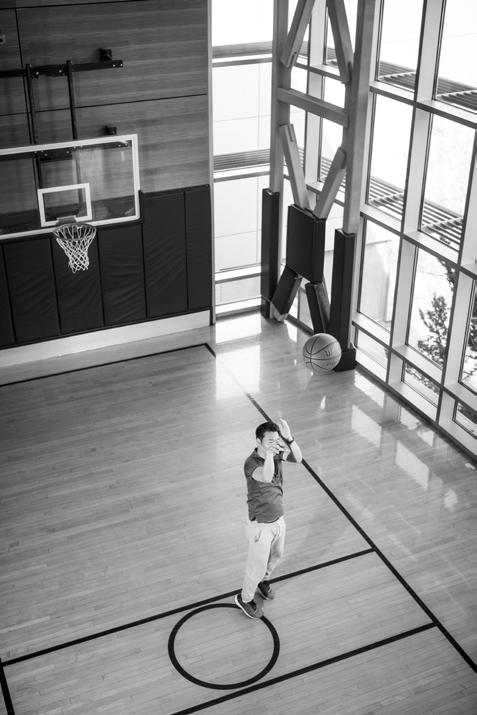
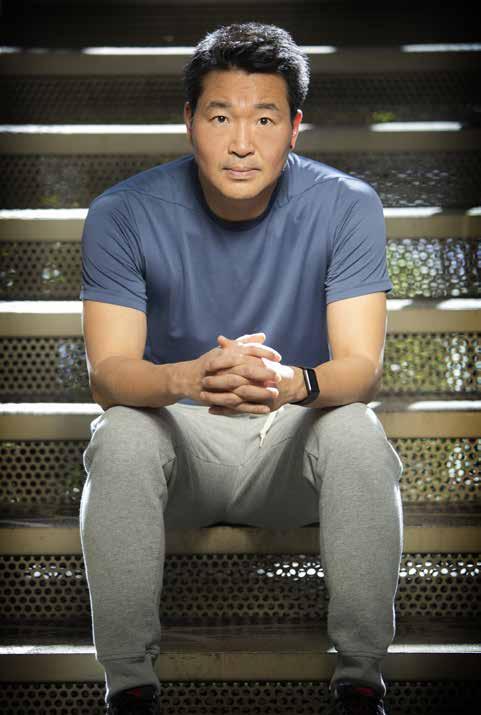
this was Scott’s first time using an AED machine, it’s not his first experience with a cardiac incident. In 2023, Scott suffered a massive heart attack at the Club while sitting in the sauna after a workout. “I am now fully recovered,” says Scott. “My heart function was 100 percent restored. It was great to be able to pay it forward.”
Ryan shares a similar sentiment. “I’ve been involved in numerous incidents like this,” he explains. “However, it’s rare to have the opportunity to learn about the outcome of the individual involved afterward,” he continues. “I feel truly grateful that I was able to be present to help Jake during such a critical moment. It’s a blessing to know that he was able to go home to his wife and two kids.”
A blessing is exactly how Jake describes this whole experience. “I feel like all my angels lined up for me in the right place and at the right time,” he says. “The prior Thursday night I played basketball at a church in my neighborhood. I can’t help but think that if this had happened there, the outcome would have been very different.”
Jake ended up spending four days at Overlake under the care of cardiologist Dr. Ronnier Aviles. Initial EKG and blood test results didn’t show any clear cause for his heart attack. At first it was suspected that perhaps he had a genetic issue that causes the heart to stop without warning. But after some meticulous sleuthing via an MRI and angiogram, it was determined that Jake’s heart attack was caused by a clot that resulted from a rupture formed when a small piece of plaque came loose from an artery wall. A barely healed scar at the rupture site was the final piece of evidence Dr. Aviles needed to complete the puzzle.
“Jake’s is an amazing success story,” explains Dr. Aviles. “He suffered the most common type of heart attack caused by a ruptured cholesterol plaque in the coronary arteries, and his story highlights that the chain of survival [CPR, AED usage] works. It just needs to be activated immediately, and the fact that it was for Jake is what saved his life.”
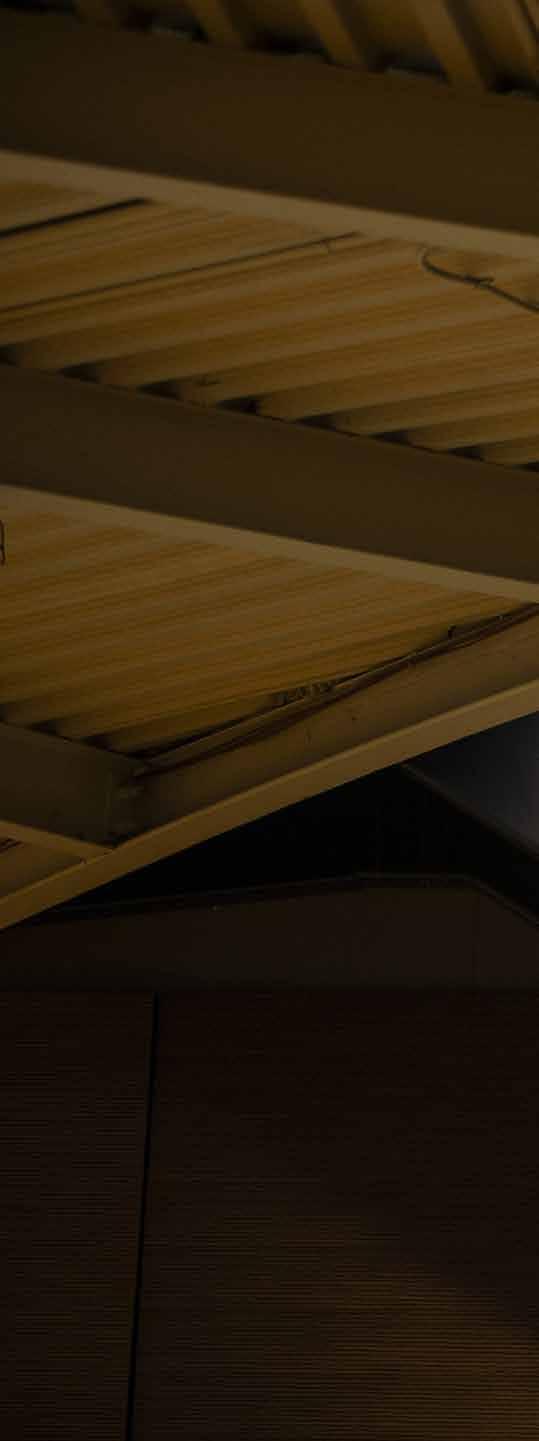
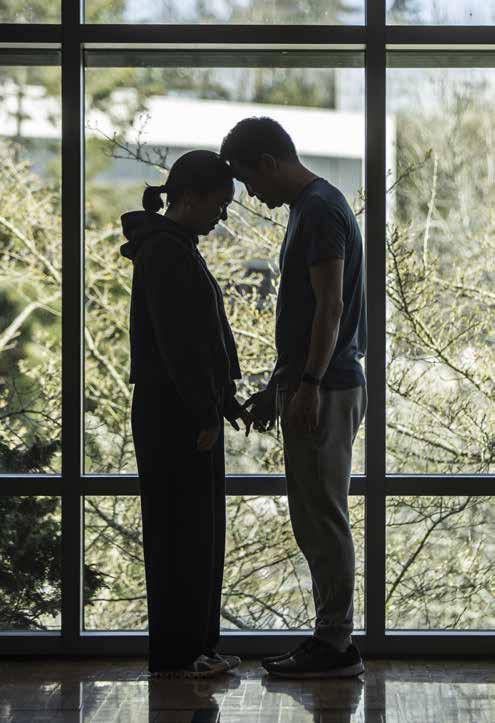

Ryan, Connie, Scott, Jane and EMTs weren’t the only people instrumental in saving Jake’s life that day. Members TRICIA IGNACIO and RICH LANE helped administer the AED, and Club employee CAMERON OLSKI joined Red Cross instructor and lifeguard BRANDON ECKHARDT as first responders. A luncheon was held in their honor on April 5. See page 56 for photos of the event.
There are six AED machines located throughout the Club in high-usage areas:
ATHLETIC
SERVICES DESK in a cabinet under the desk facing the external doors
CONCIERGE in the office behind the desk
POOL on the counter behind the lifeguard desk
BASKETBALL GYM on the wall under the stairs to the elevated track
TENNIS AREA on the wall just inside the office
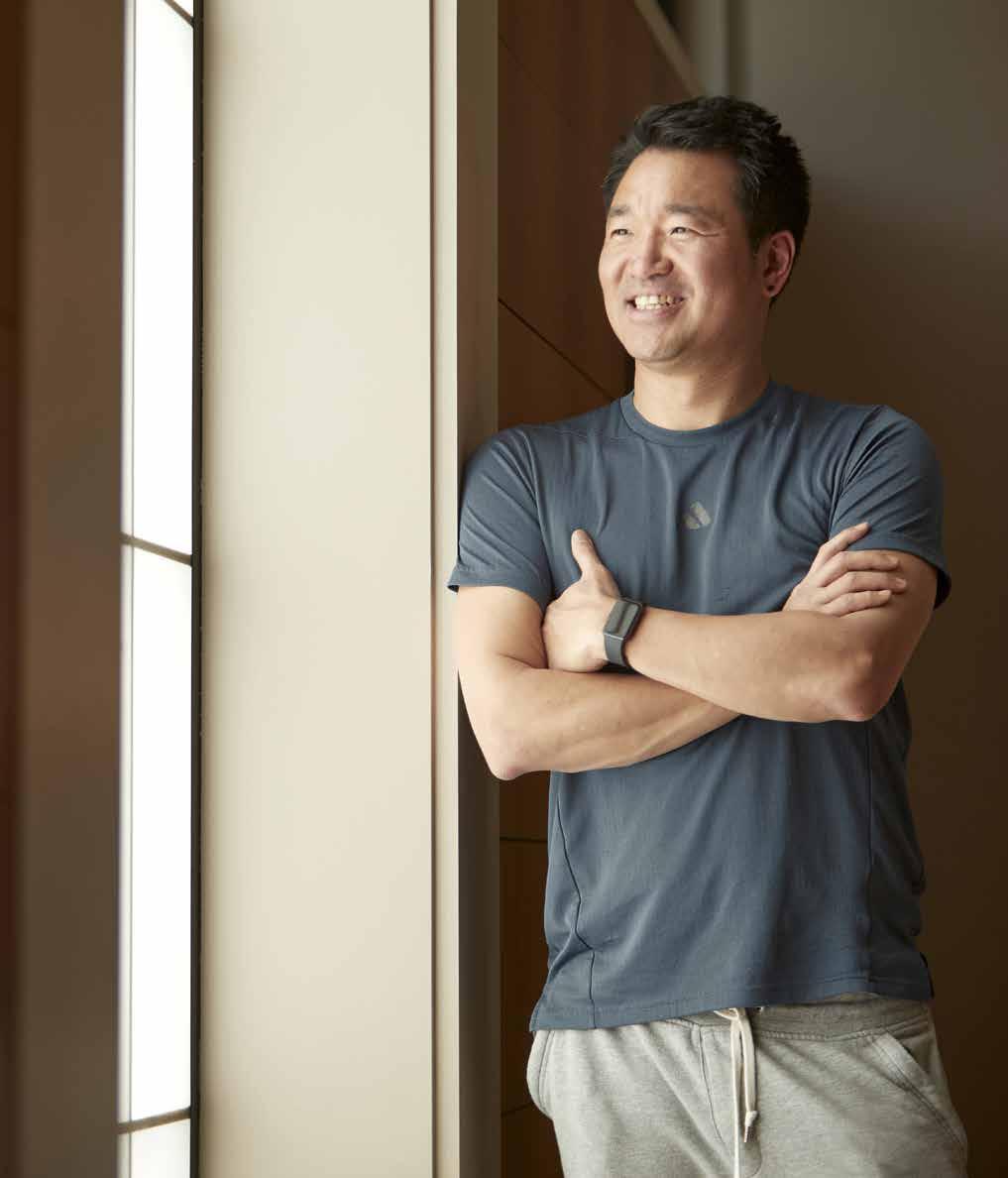
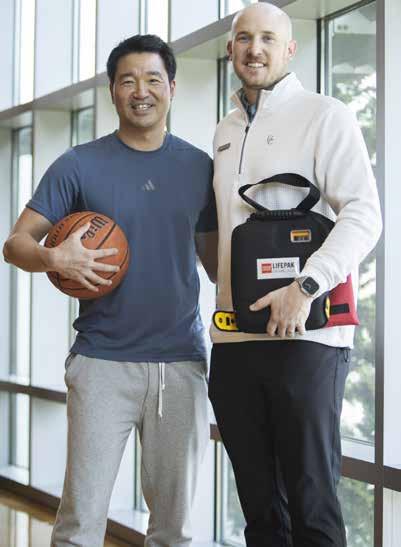
STUDIO 2 on the wall outside of the bathrooms ➔ Bellevue Club offers regular adult and pediatric Red Cross CPR, first aid and AED training for members. Sign up via the Aquatics calendar at members.bellevueclub.com.
“Our AEDs are Stryker LIFEPAK 1000, the same top-tier machines that Bellevue police officers have in their cars, and they are very, very easy to use,” explains Associate Athletic Director Scott Stone. “The machine walks you through how to use it and when or if to administer a shock,” he continues. “We encourage members and guests to use them without hesitation if someone has lost consciousness and does not appear to be breathing.”
taking a week off, Jake returned to his job as a software engineer at Amazon with a stent in his artery, prescriptions for several different medications, 12 weeks of cardiac rehab and encouragement from Dr. Aviles to view the experience not as a trauma but as a gift. Which is Jake’s absolute goal.
“All these people somehow ending up being at the Club on that morning by their own choice, and I’m the biggest beneficiary of all those choices and the confluence of events,” says Jake. “Even joining Bellevue Club in the first place helped save my life,” he continues. “If there’s one thing I’m taking out of the incident it’s that I need to be more responsible about my health for my kids and my wife. For them, I need to really pay attention to this.”
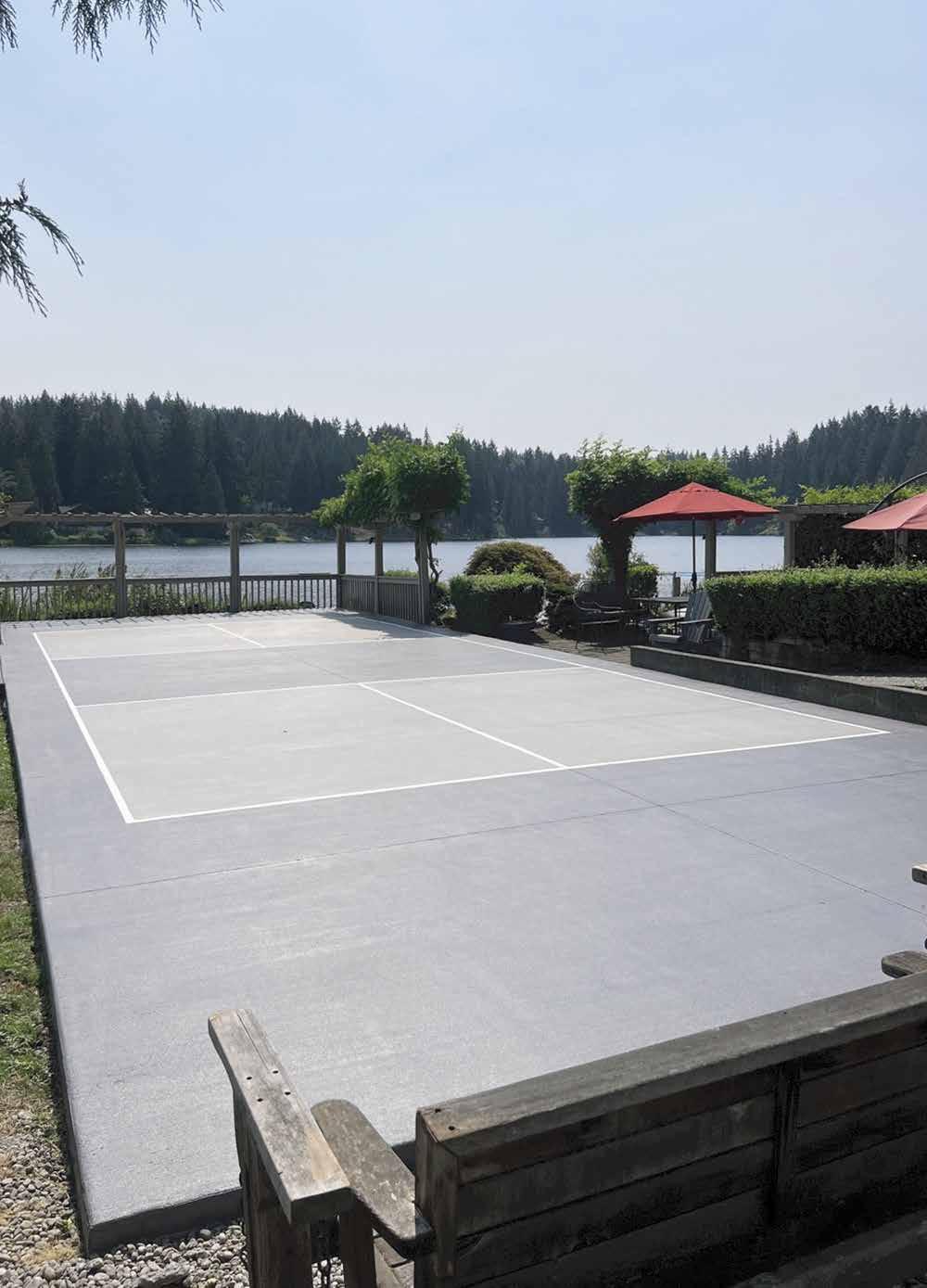

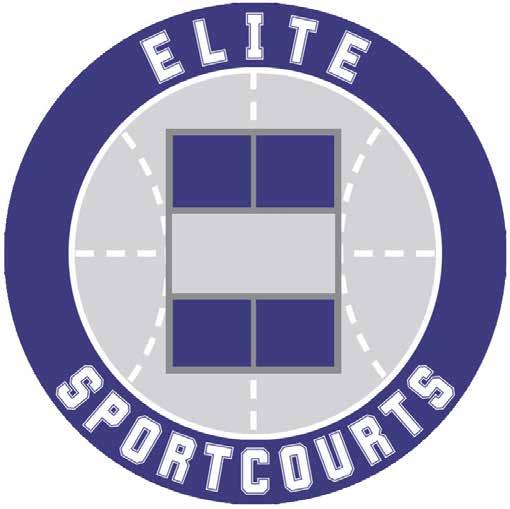
EliteSPORTCOURTS brings your sport court vision to life with fully custom, high-end courts. From multi-sport to single-sport designs, we deliver top-quality craftsmanship backed by years of experience and a passion for excellence. For a seamless, professional experience and the ultimate backyard sport court, call us today!
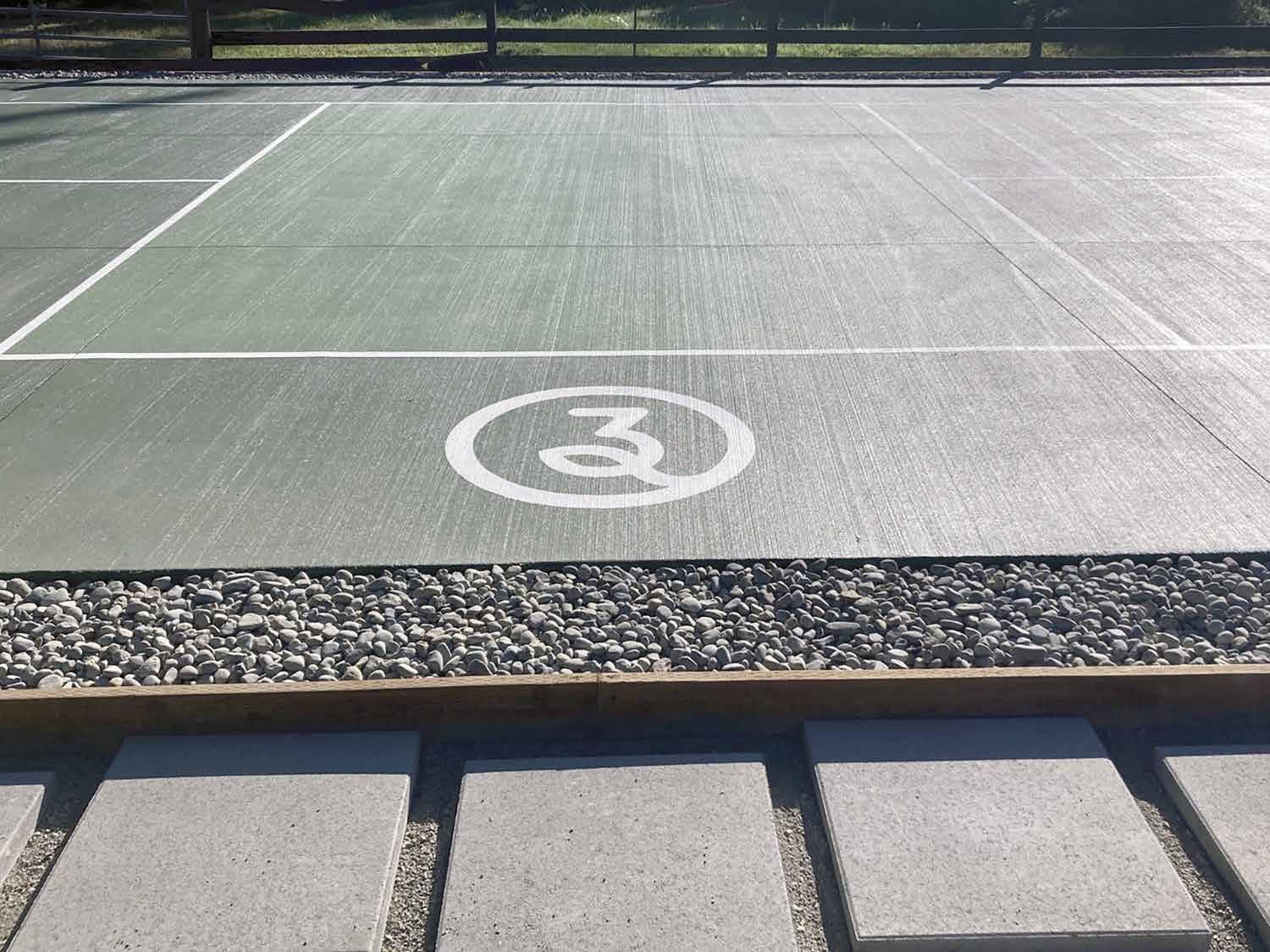
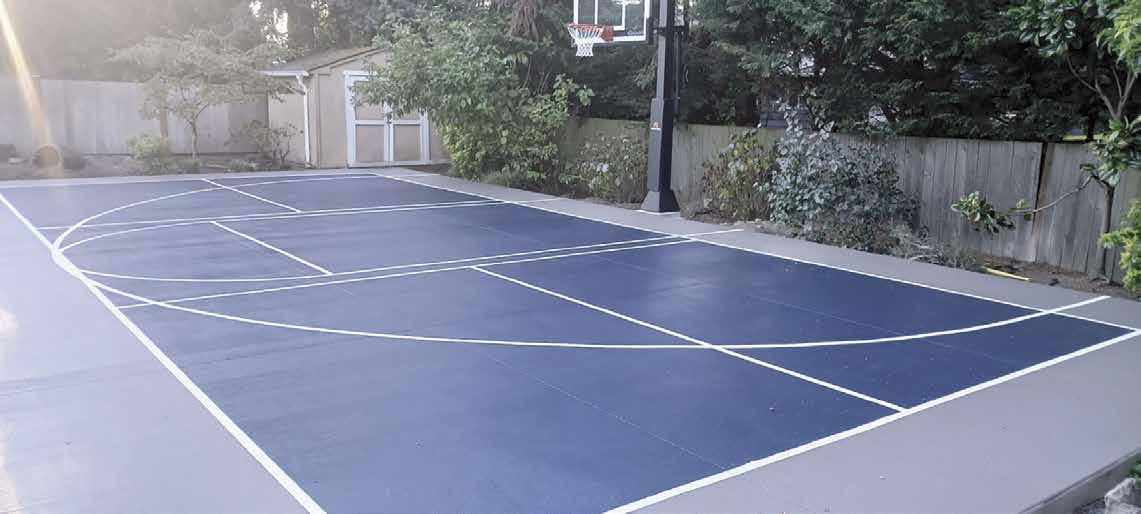
FOUNDATION PREPARATION
• Excavation
• Grading
• Subgrade compaction
• Moisture barrier
• Rebar reinforced 5-inch slab
CUSTOM DESIGN
• Single-Sport
• Multi-Sport
• Striping
• Logos
• Saw Cuts
CUSTOMER EXPERIENCE
• Free consultation
• Personalized plan & design
• Dedicated customer support
• Professional service
• ROI
ADDITIONAL SPECIALITIES
• Pavers
• Driveways
• Patios
• Turf
• Retaining Walls www.elitesportcourtswa.com
written by christina opalka
It’s springtime and gardens in the Pacific Northwest are in a marvelous mood. Rhodies are trumpeting at peak bloom, alliums’ purple drumsticks are on heady display, magnolias are crooning in velvety creams and pinks and peonies are exuding star power before most roses have even woken up.
The gorgeous blooms of spring are a fleeting and weatherdependent indulgence of the senses in our area. Before the show is over, plan a visit to one of our many botanical gardens, each with unique cultural and floral offerings. Make sure these four spots are on your list.


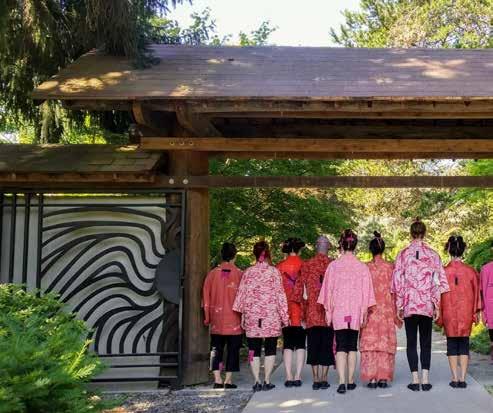
1 2 3

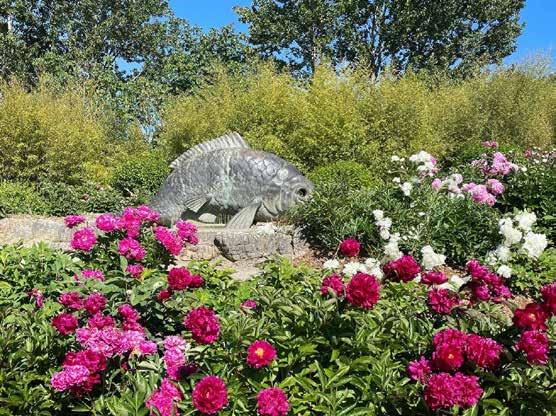

With an astounding 140 acres of breathtaking landscapes on Bainbridge Island, this sanctuary lures visitors from around the world to amble among a wide array of landscapes and moods. Vibrant meadows give way to welcoming forests, lush moss and lichen gardens sidle up to an explosion of color in the Rhododendron Glen and the peaceful Reflection Pool feeds the soul in any season. Visitors will find 50 varieties of wildflowers and 50,000 blooming bulbs in the recently expanded Buxton Bird Marsh and Pollinator Meadow. Be sure to wander through the Birch Garden, a grove of slender white trees that shelter delicate forest flowers below. Plan at least 90 minutes to leisurely explore this wonderland.
Spring highlight: Lift your spirit by joining a mindfulness meditation in the Reserve’s Japanese Guest House, which is surrounded by an award-winning garden designed by Fujitaro Kubota in the mid-1950s.
➔ 7571 NE Dolphin Drive, Bainbridge Island | bloedelreserve.org 206-842-7631

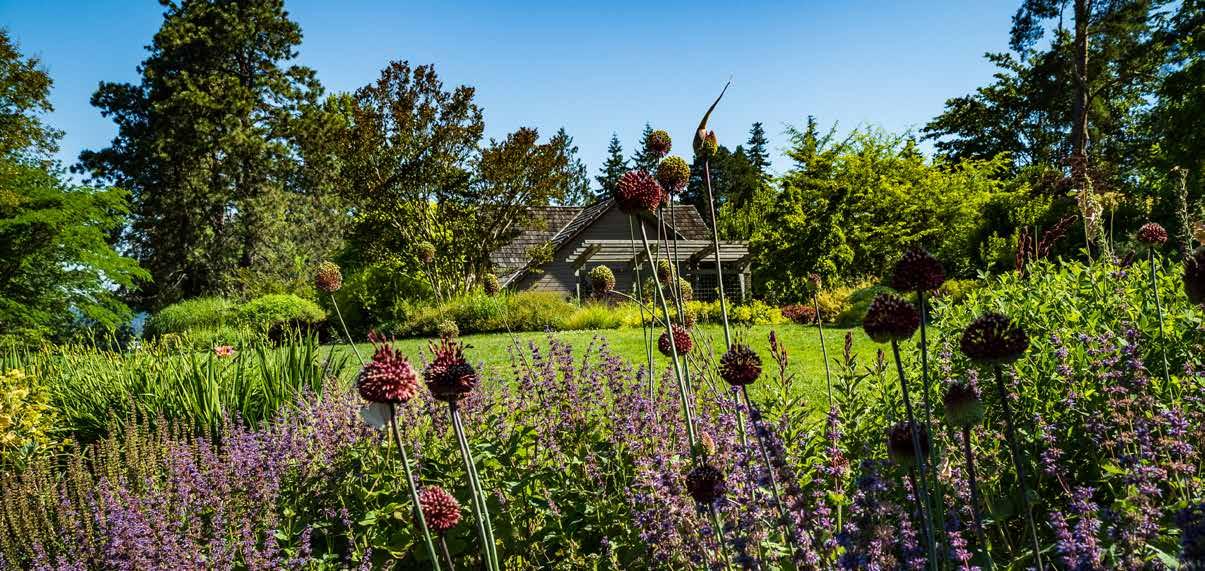

Just minutes from Bellevue Club is the 53-acre Bellevue Botanical Garden, a community treasure offering both world-class displays for leisurely visits as well as quick, uplifting walks even when time is short. Let its sparkling ground cover garden and babbling mountain stream remind you of spring’s awakening, take joy from its slender Siberian and violet Japanese irises shining in its Rain Garden, and thrill to its Ravine Experience and 150-foot suspension bridge. Local gardeners: now’s the time to derive inspiration from the botanical garden’s workshops and expert designs for your own native planting, perennial border or trending “modern meadow” while there’s still plenty of season left to make updates.
Spring highlight: Pick a sunny day in May or June to look for butterflies dancing in the Fuchsia Garden, a vast and delightful collection cultivated by the Eastside Fuchsia Society since 1992.
➔ 12001 Main Street, Bellevue | bellevuebotanical.org | 425-452-2750

Tucked away in the Rainier Beach neighborhood of Seattle, this 20-acre retreat blends Japanese landscaping traditions with Pacific Northwest flora. Spring is your chance to glimpse its signature azaleas and rhododendrons in full color, and in May its glorious wisterias. The gardens, designed a century ago by visionary plantsman Fujitaro Kubota, are dotted with 11 tranquil ponds, two dazzling red bridges and awe-inspiring specimen trees.
Spring highlight: Join an expert-led Pollinator Safari on June 7 or one of the ongoing tours to learn more about the rich history and design of this unique place.
➔ 9817 55th Ave S, Seattle | kubotagarden.org | 206-684-4584






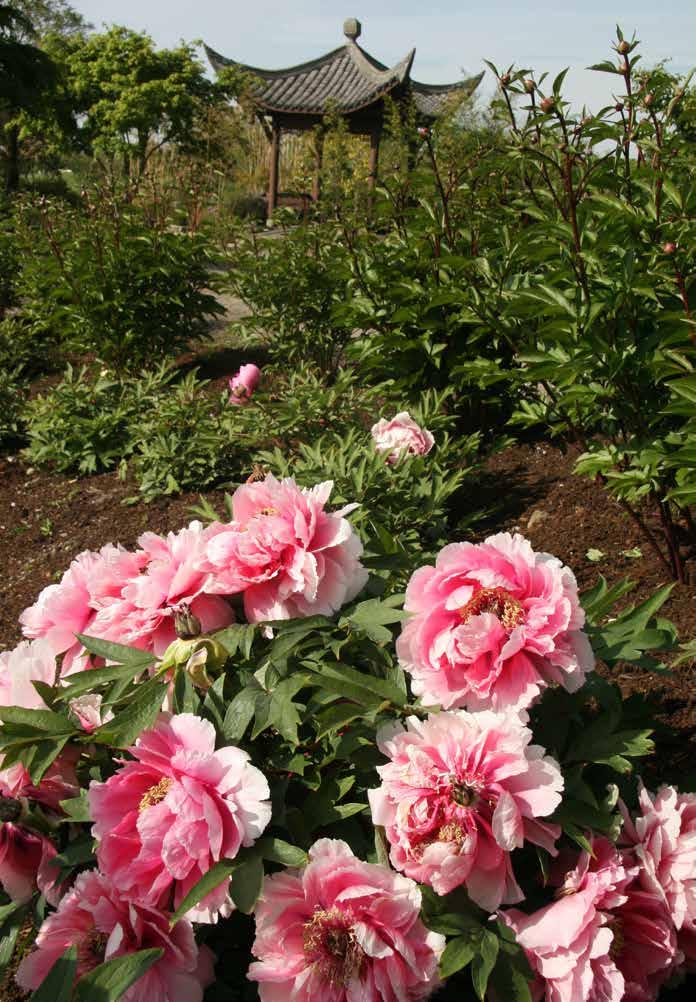
Graceful, Sichuan-style structures anchor this 4.6-acre gem in West Seattle, including a spring-themed courtyard and pathways to picturesque pavilions. Designed to embody chi, the traditional Chinese concept of universal energy, the garden incorporates element of yin (earth) and yang (heaven) to mirror the rhythm and cycle of life. Among its many highlights is the endangered Davidia involucrata, or “dove tree,” known for its delicate paperlike white bracts at the base of each flower. Extend your visit by cycling the West Duwamish Greenbelt, Seattle’s largest contiguous forest, and walking the neighboring six-acre Arboretum on the campus of the South Seattle College.
Spring highlight: Don’t miss the hundreds of herbaceous peonies, tree peonies and stunning Itoh varieties as they bloom in the Luoyang Peony Garden, best in early to mid-May.
➔ 5640 16th Ave SW, Seattle | seattlechinesegarden.org 206-934-5219




•
•
upgrades and smart investments.
• Personalized, resultsdriven guidance every step of the way.




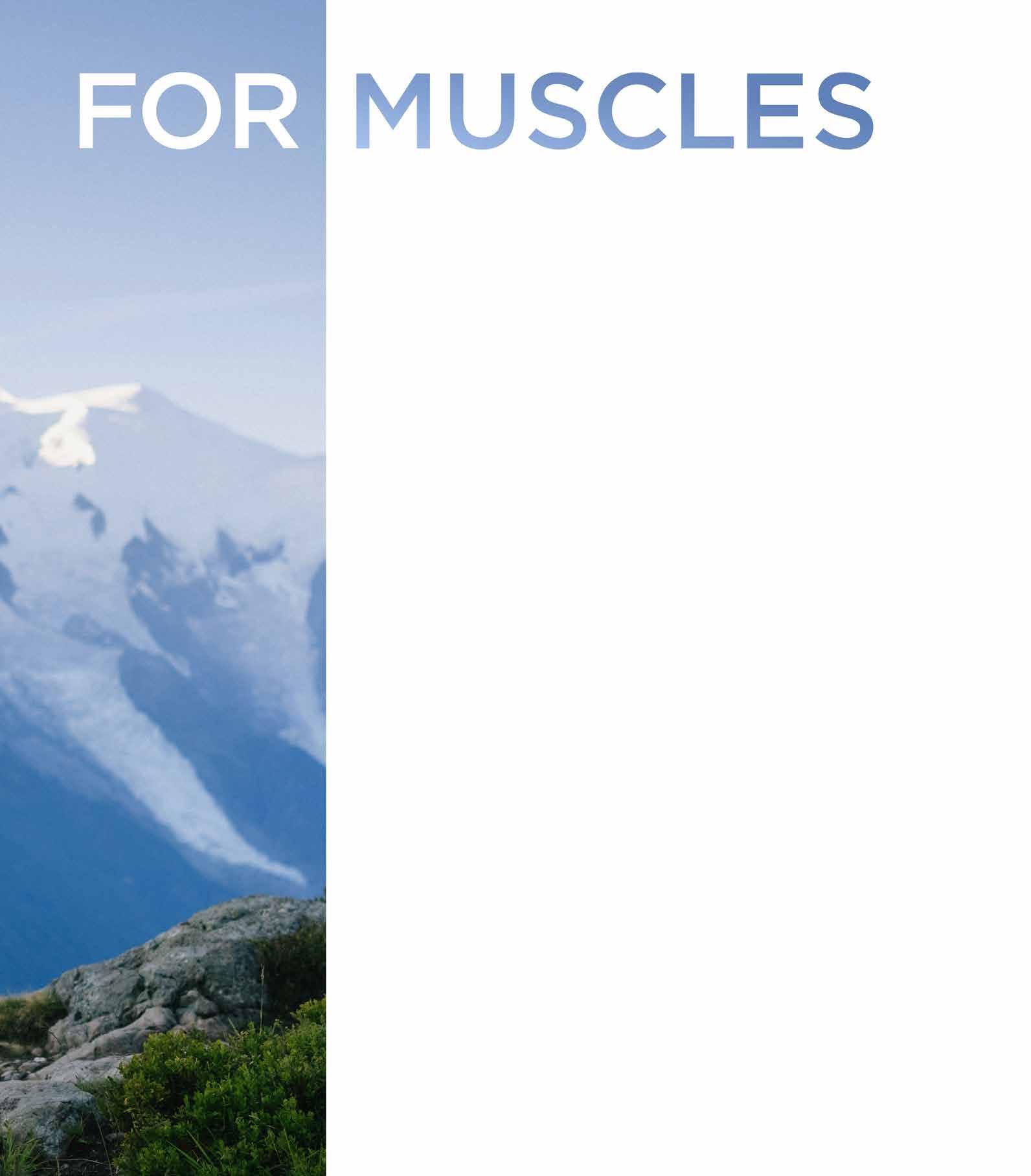
written by emilina lomas
Endurance athletes go the distance—literally. Whether running, cycling or rowing, their training is designed to keep them performing for hours. But endurance capacity isn’t solely about logging miles, strength training is also essential for building stamina and efficiency and should be a cornerstone in any endurance athlete’s training.
After a marathon, you probably feel the effects of pounding on the pavement— this pain and soreness reflects the stress placed on your muscles, tendons and bones. The same goes for cyclists who experience knee pain from thousands of pedal strokes or swimmers who struggle with shoulder tightness from constant overhead movement. Over time, these repetitive motions can lead to overuse injuries and joint instability.
“In endurance sports, the body is subjected to continuous, repetitive movements that can lead to muscle imbalances as well as wear and tear on muscles, joints and connective tissue,” explains Bellevue Club personal trainer and competitive triathlete Beth Draeger.
This is where strength training comes in. By building strength in key muscle groups and reinforcing movement patterns, athletes can offset imbalances and enhance durability, ultimately helping to prevent injuries and increase their longevity in endurance sports.
“When moving heavy loads (i.e., weight lifting or strength training), the body is challenged in different movement patterns while also developing the
neural pathways for the simultaneous recruitment of the greatest number of muscle fibers,” says Beth. “As these pathways are further developed, they can be translated to an individual’s specific sport, creating a stronger and more durable athlete.”
In addition to stabilizing the joints, research has shown that strength training increases bone density, strengthens tendons and ligaments, and builds lean muscle mass—all critical components for preventing injuries that could sideline an athlete.
PERFORMANCE GAINS: MORE POWER, LESS EFFORT
One of the biggest misconceptions about strength training for endurance athletes is that heavy lifting might lead to bulky muscles or decreased flexibility. Not so, says Beth. “Through strength training, muscles learn to work together and use oxygen more efficiently to maintain power and velocity. As lean mass increases, oxygen transport improves, more rapidly providing oxygen to the muscles to contract and perform work,” she continues. This means that the stronger an athlete becomes, the less effort is required to sustain speed and endurance.
Improved coordination also plays a role. “While an individual develops the ability of their muscles to work harder for less effort, they are simultaneously refining movement patterns and becoming more efficient through form improvements,” she says. The result? A body that moves faster, lasts longer and experiences less fatigue.
Many endurance athletes shy away from strength training because they worry it will take time away from their primary sport. But the good news is that even a small investment in strength work can yield significant advantages.
“The addition of even two or three 30-to 60-minute focused strength sessions can result in substantial benefits in lean mass development and movement pattern improvements,” Beth notes. She also emphasizes the importance of being strategic. “It is important to be purposeful and efficient with a strength training program as well as to start with lower volume and loads, progressing as your strength lifting skills improve.”
Strength training isn’t a one-size-fits-all endeavor. The best exercises depend on an athlete’s specific sport, weaknesses and goals. “Exercise selection is highly sport dependent,” Beth says. “The needs of a rower are vastly different from those of a runner, which are equally different from those of a swimmer. To determine the best exercises for your specific sport, it’s best to reach out to an experienced coach who can direct you toward information or a program to follow.”

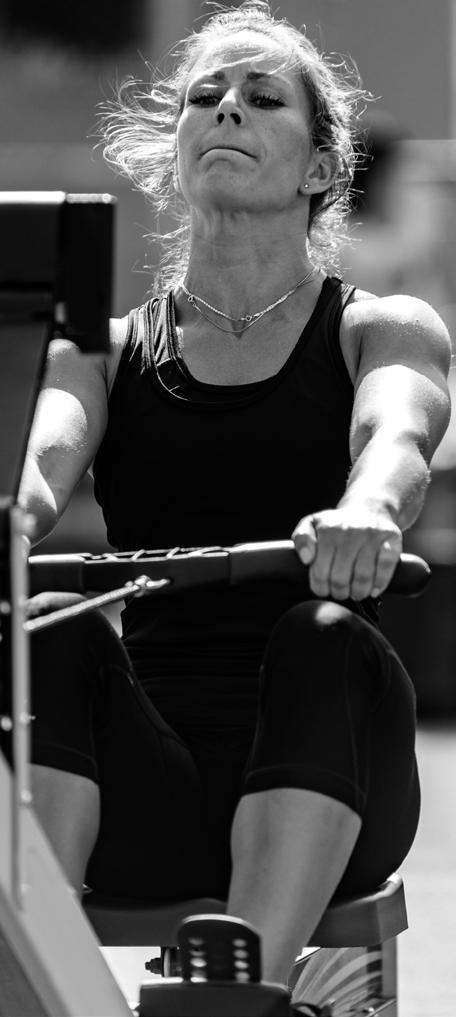
Build lower-body strength for powerful strides and pedal strokes.
Improve upper-body endurance and posture for both swimmers and cyclists.
planks , russian twists , anti - rotational exercises
Enhance stability and prevent compensatory movements that lead to injury.
bulgarian split squats , step - ups
Correct muscular imbalances in running and cycling where one leg may dominate or compensate.
STRENGTH TRAINING: YOUR SECRET WEAPON
If you’re an endurance athlete looking to improve performance, prevent injury and increase efficiency, strength training isn’t optional—it’s essential. As Beth puts it, “By strengthening the muscles, joints, bones and connective tissue, athletes can combat the strain induced by endurance sports, resulting in fewer injuries and a prolonged career in the sport.” So the next time you’re mapping out your training plan, don’t just focus on miles—make space for muscle. Your future self will thank you.

In the heart of downtown Bellevue, amidst stunning Cascade Mountain views, sits Pacific Regent Bellevue, an experiential Independent Living community. With a curated blend of premier amenities, personalized services, and elegant charm, this is where retirement meets refinement.
Visit: 919 109TH Ave NE, Bellevue, WA 98004 Call: 425-292-5216

written by amanda zurita
Transformed from a tiny fishing village into a global metropolis,
the island nation and city-state of Singapore is a modern marvel in every sense. After gaining independence in 1965, this former British colony rapidly developed with a vision grounded in order and organization. The grand plan paid off because, today, Singapore leads Asia in financial services, urban planning, technological innovation and infrastructure while also standing out as a top destination for awe-inspiring attractions, vibrant food culture and over-the-top luxuries.
There’s never been a better time to visit this thriving capital, and it’s never been easier. Singapore Airlines offers nonstop flights four days a week from Seattle to Singapore’s Changi Airport (consistently rated as one of the best in the world). With so much to see, planning is key. We’ve compiled a must-visit list of activities, restaurants and hotels to kick-start a memorable adventure in Singapore.

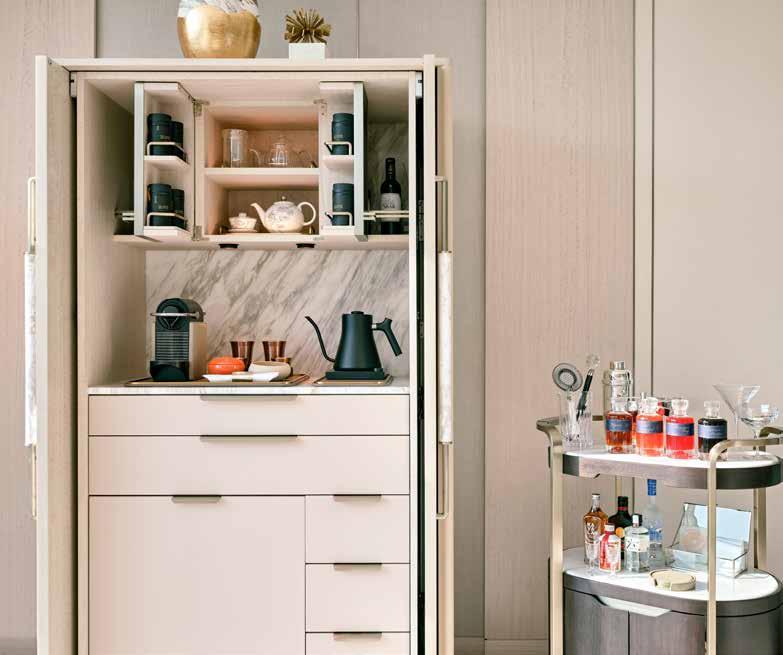

MARINA BAY SANDS
Undoubtedly Singapore’s most iconic building, Marina Bay Sands is a massive complex housing a hotel, a high-end shopping center and a lively casino. Its futuristic, boatlike design features three towers connected by the SkyPark on the 56th floor, where you’ll find the world’s largest rooftop infinity pool (accessible only to hotel guests). Swimming laps with stunning panoramas makes it worth the stay alone, but the spacious, elegant rooms offer top-tier amenities and floor-to-ceiling windows with city or bay views. With nearly 50 on-site dining options and a serene spa, you could spend your whole time in Singapore without leaving the resort.
10 Bayfront Ave marinabaysands.com
What began as a modest 10-room bungalow in 1887 bloomed into the grande dame of luxury hotels in Singapore. Raffles is where Rudyard Kipling found inspiration for The Jungle Book while sipping cocktails in the Writers Bar. John Wayne, Ava Gardner, Elizabeth Taylor and countless other celebrities and dignitaries have stayed here. An oasis in the city center, the property offers lush gardens, a rooftop pool and tranquil suites with butler service. Among its nine bars and restaurants is the legendary Long Bar, where the Singapore Sling was first created. Famed doormen dressed in immaculate turbans welcome you as you enter this slice of Singaporean history.
1 Beach Road raffles.com/singapore

SINGAPORE HAS FOUR OFFICIAL LANGUAGES: MALAY, MANDARIN, TAMIL AND ENGLISH. MOST LOCALS ARE FLUENT IN ENGLISH, MAKING THE CITY SIMPLE TO NAVIGATE.
Part botanical garden, part forest of the future, Gardens by the Bay is an otherworldly experience. The complex is home to the muchphotographed Supertrees, a grove of branching vertical gardens that harvest solar energy and grow over 150,000 plants. Elsewhere, the Cloud Forest has a 115-foot indoor waterfall, while the Flower Dome is the largest glass greenhouse in the world. Strolling the gardens is free, though you’ll need to pay admission to the Cloud Forest, Flower Dome and the OCBC Skyway suspended among the Supertrees. Each evening, the Supertrees glow during the Garden Rhapsody light and sound show at 7:45 and 8:45 p.m.
18 Marina Gardens Drive gardensbythebay.com.sg
Open daily 9 a.m.–9 p.m.

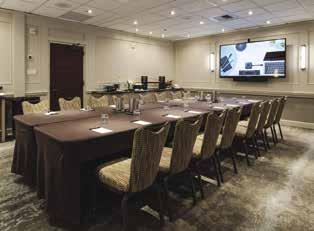
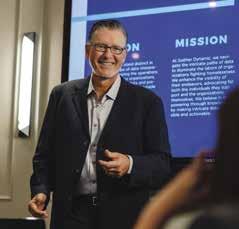
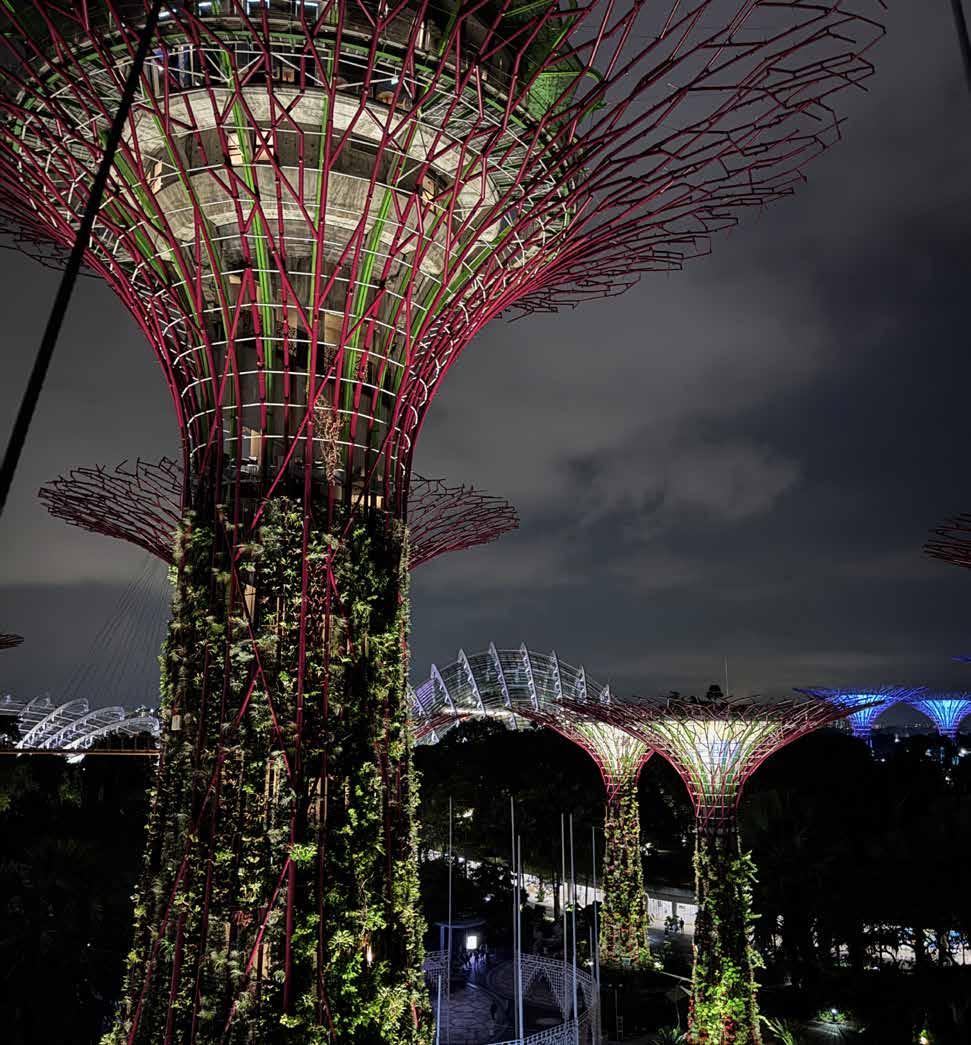

Bellevue Club is equipped to host corporate events of any size, from large-scale gatherings to smaller groups— and members can easily reserve a small conference room by the hour through the app.
Tracing their ancestry to 15th-century Chinese traders who married local Malay women, the Peranakan community has played a significant role in Singapore’s history and economic development. By the 19th century, many Peranakans held prominent positions as shipping tycoons, plantation owners and bankers. Because they spoke Malay, Chinese and English, they often acted as intermediaries between locals and the British colonial government. Alvin Yapp, owner of the Intan Museum, once described them as the “original crazy-rich Asians.”
Yapp has spent the last 30 years collecting thousands of Peranakan artifacts displayed in his home-turnedmuseum, the Intan. He personally guides visitors through his treasure trove of beaded slippers, enamel tiffin boxes and intricate artwork. Afterward, guests are invited to sit with Yapp for tea or a meal colored with conversation about Peranakan culture and traditions.
For an even deeper dive into Peranakan culture, visit the Peranakan Museum near Fort Canning Park.
69 Joo Chiat Terrace the-intan.com
Visits by advance booking only
Designed to resemble a giant white lotus, the ArtScience Museum explores the connection between art, design, science, culture and technology. Spread across 21 gallery spaces, including a virtual reality gallery, the museum hosts a series of permanent and rotating exhibitions in partnership with institutions like the Smithsonian and the Science Museum in London. These immersive and interactive shows explore a wide range of topics, from deep-sea creatures to space exploration and digital art. Editor’s note: The museum’s permanent exhibit, Future World, is temporarily closed for a revamp through summer 2025. But don’t let that stop you from checking out one of the most unique sightseeing experiences in Singapore.
6 Bayfront Ave marinabaysands.com/museum
Open Sunday–Thursday 10 a.m.–7 p.m., Friday and Saturday 10 a.m.–9 p.m.
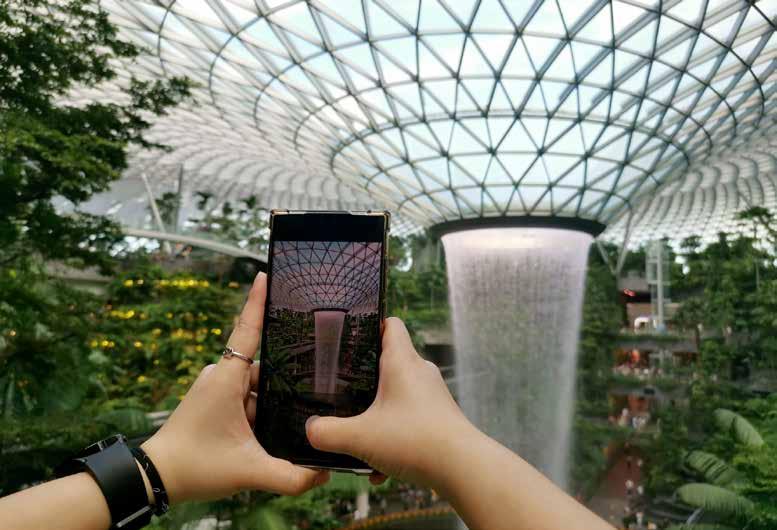


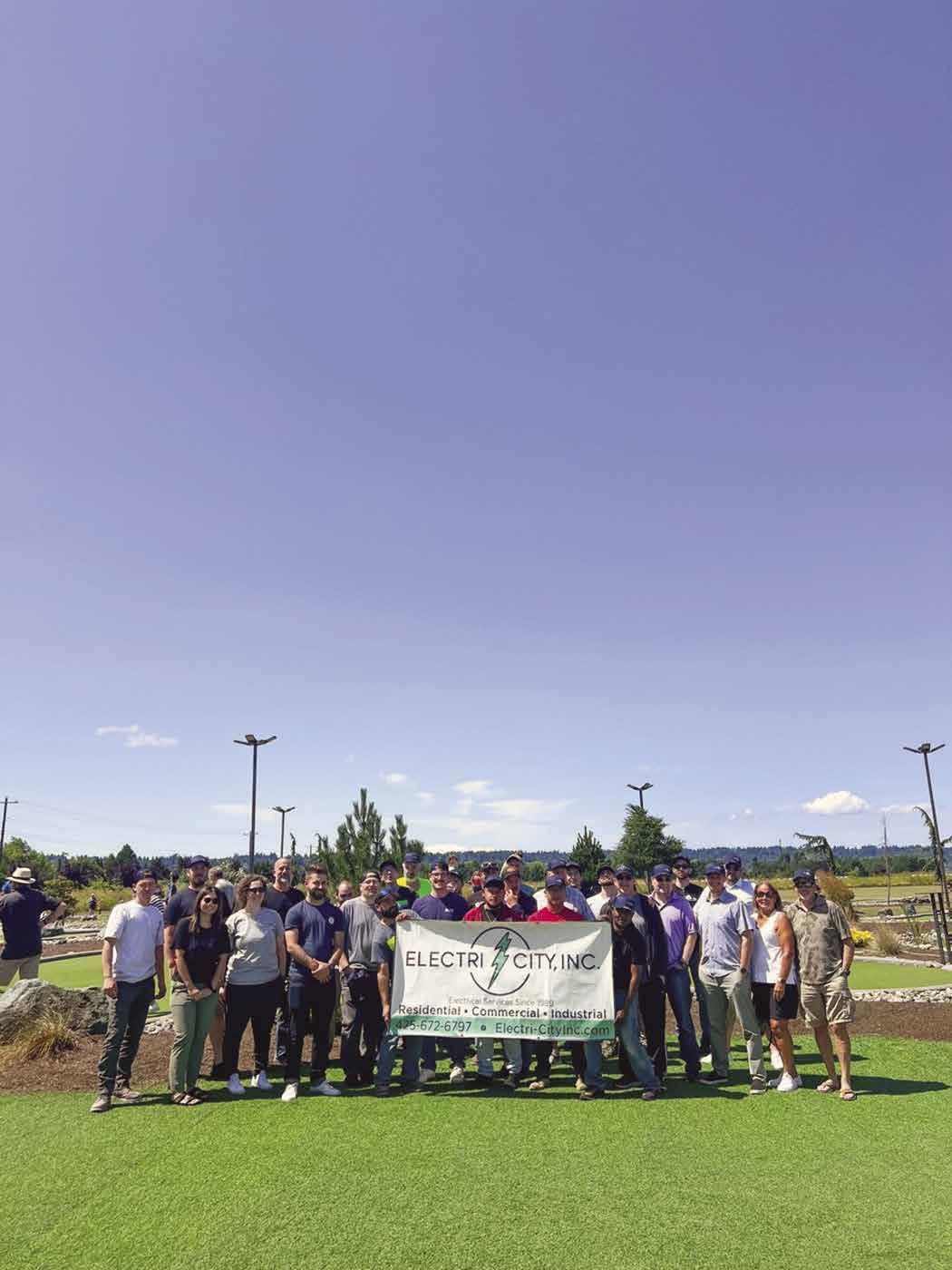

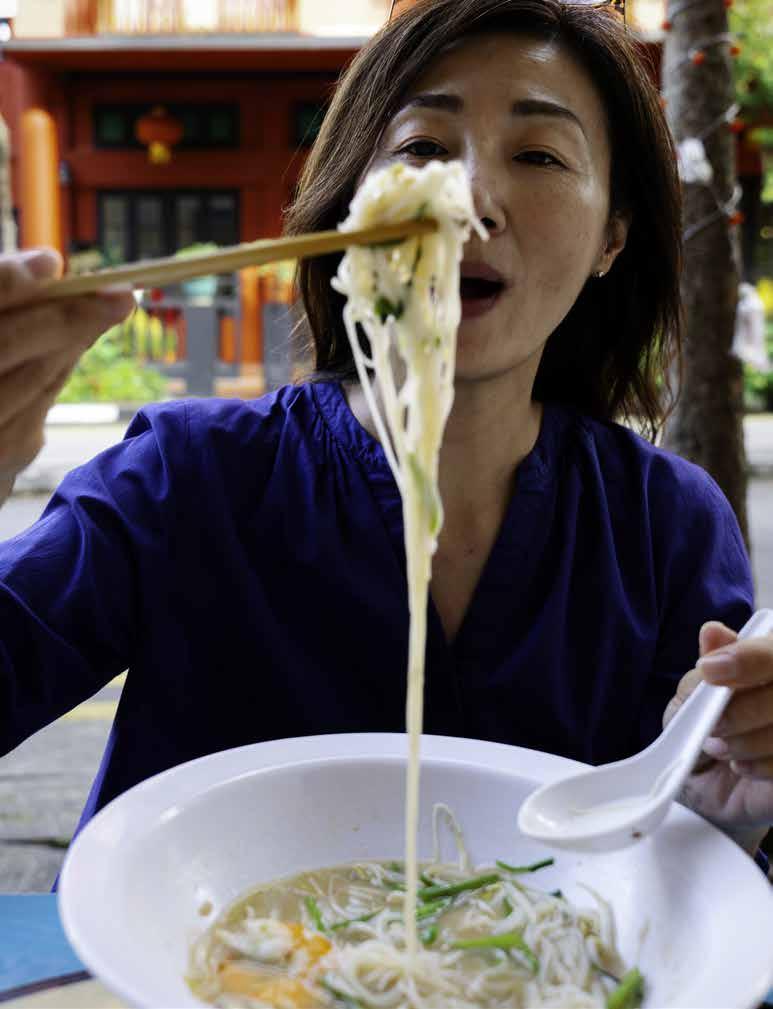

Singapore’s immigrant population surged in the early 19th century when an open-door policy was established under British rule to meet the demand for laborers at the ports. As thousands of people arrived from Malaysia, China and India, so did their culinary traditions. All around the city, vendors known as hawkers set up makeshift carts serving affordable comfort food. Although their services were seen as essential, there were issues around sanitation. To address these concerns, in the 1960s the government relocated the hawkers to clean, carefully monitored hawker centers spread across the city. Hawker culture is so deeply embedded in Singaporean life that UNESCO added it to the Representative List of the Intangible Cultural Heritage of Humanity in 2020.
Today, there are over 120 hawker centers around Singapore. Stop by the MAXWELL FOOD CENTRE to try the famed namesake dishes at Tian Tian Hainanese Chicken Rice or Maxwell Fuzhou Oyster Cake. With more than 100 stalls and most dishes priced under $10, your options are seemingly endless.
Get a taste of Peranakan cuisine at Blue Ginger, a family-run institution set in a three-story shophouse on Tanjong Pagar Road in Chinatown. For over two decades, this restaurant has preserved tradition through time-honored recipes and warm hospitality. Peranakan culture is defined by a close sense of community, which means ordering a selection of plates to share is highly encouraged. Try the crispy ngo hiang, deep-fried minced meat, pork and prawns encased in a bean curd skin, or the aromatic beef rendang, a savory stew of beef braised in coconut milk and spiced with ginger and lemongrass.
97 Tanjong Pagar Road theblueginger.com
SINGAPORE IS A CITY OBSESSED WITH CLEANLINESS, SO MUCH SO THAT THEY BANNED THE SALE OF CHEWING GUM IN 1992. BEST TO PACK SOME MINTS INSTEAD—ANYONE FOUND CHEWING GUM (ESPECIALLY SPITTING IT OUT) WILL FACE FINES.
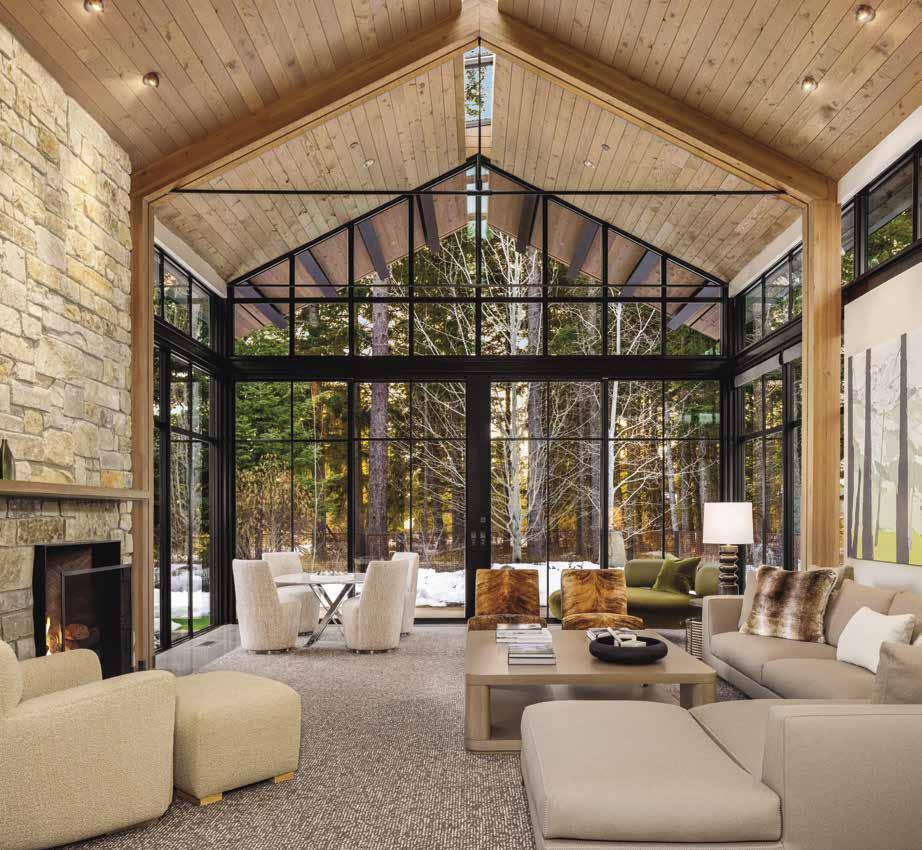











Jake Yoon and his family were joined by the guests, members, EMTs and Club employees who were instrumental in
April 5.


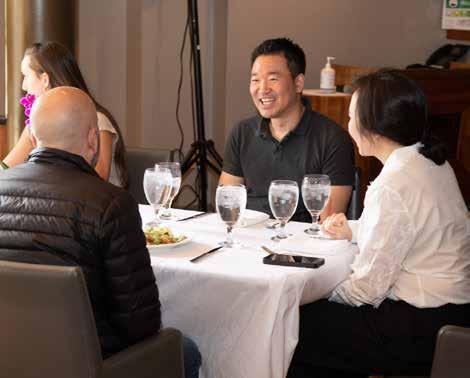
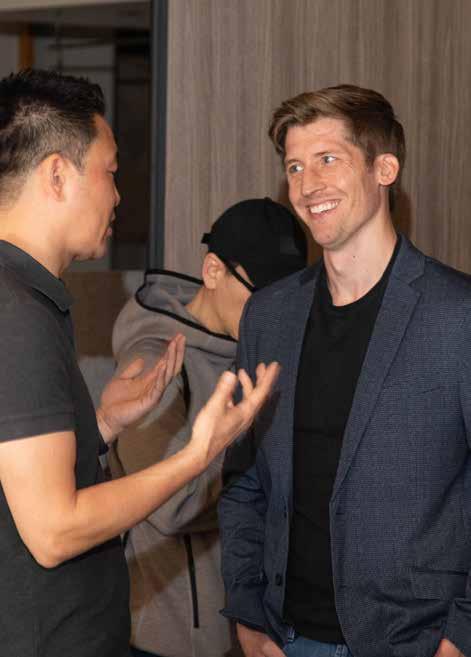
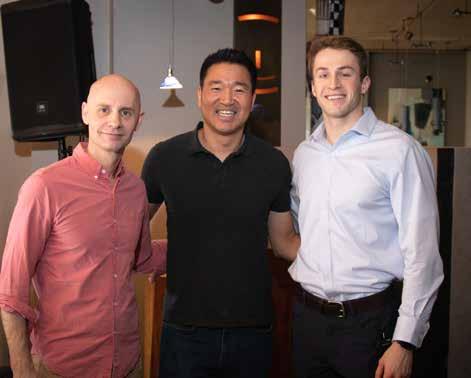
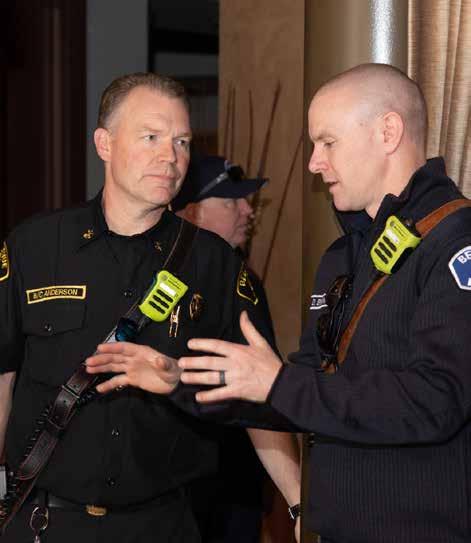
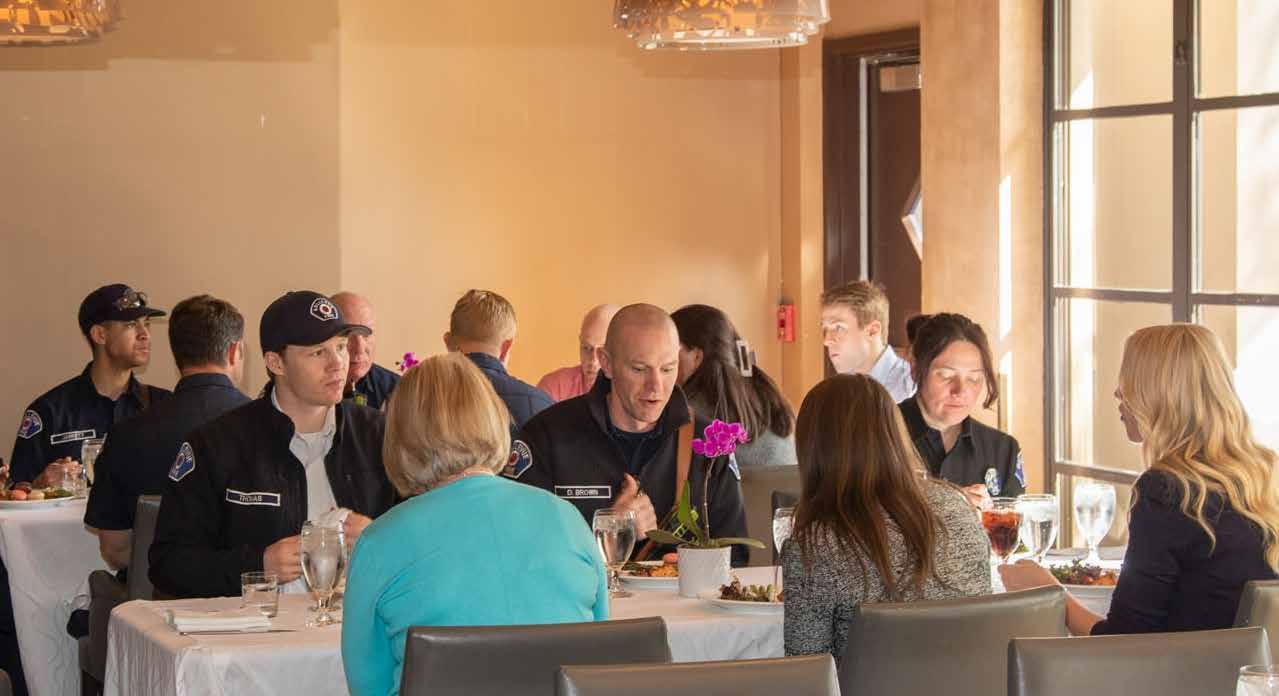
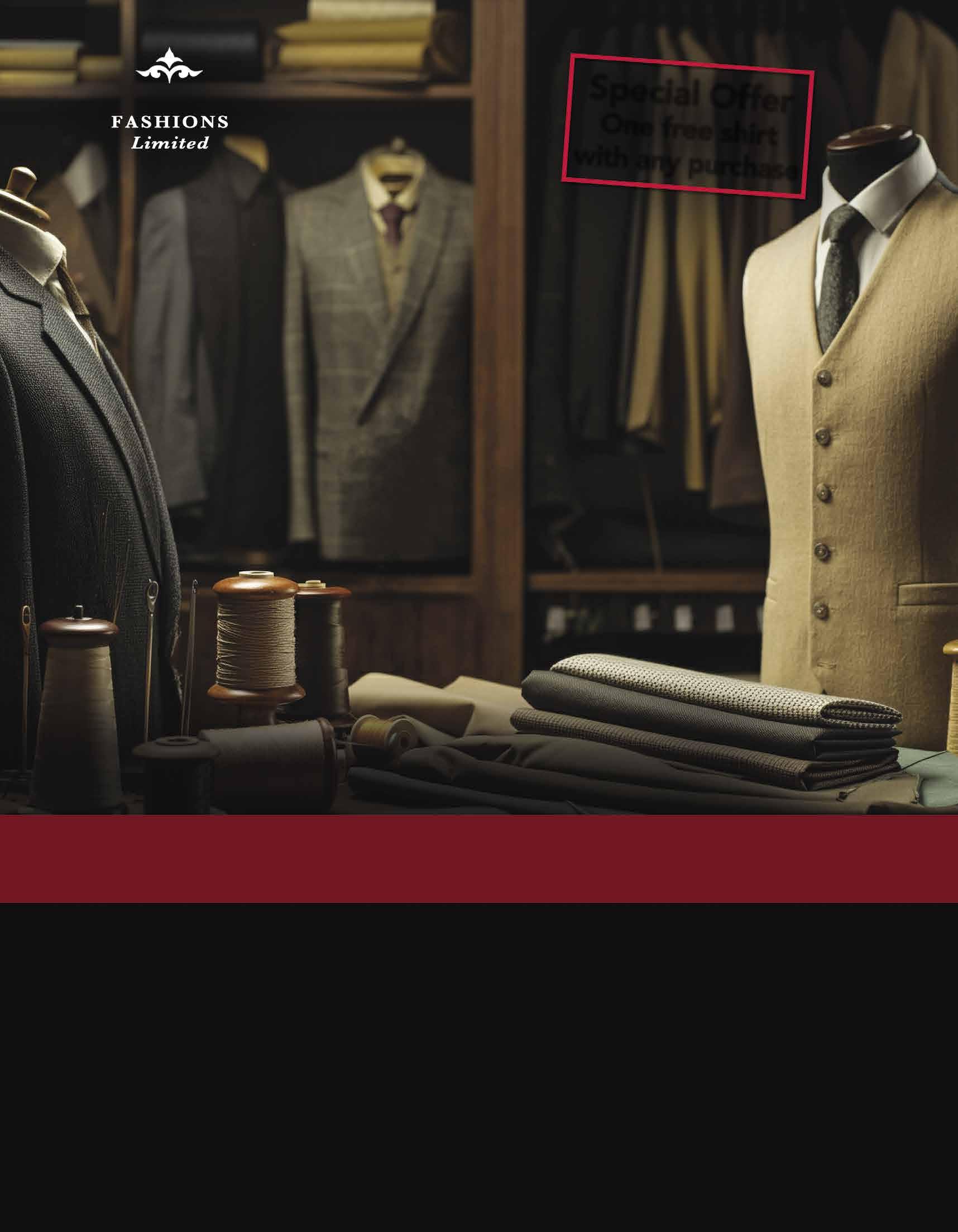

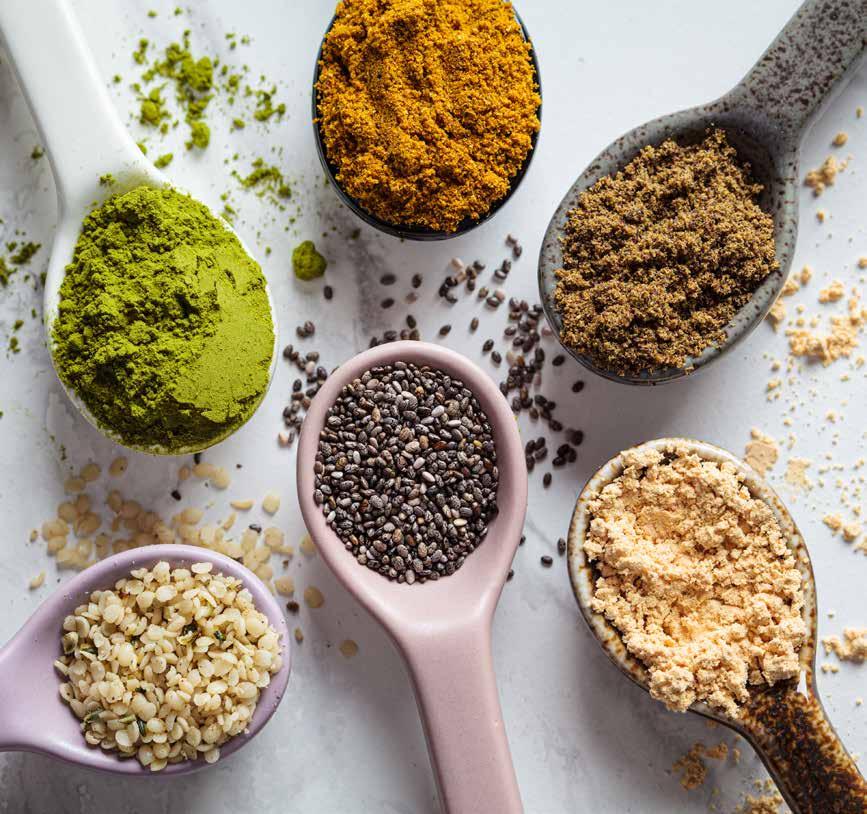
You see them on the Market menu, but what are those smoothie add-ons anyway? We've picked a few of the lesser-known options to highlight so you can determine which one aligns with your fitness goals.
ASHWAGANDA (Withania somnifera)
Highly prized by practitioners of Ayurveda, the 3,000-year-old traditional medical system of India, Ashwaganda can help counteract the effects of stress and anxiety and increase stamina and memory. It’s a gentle, tonifying herb that works best over time and responds by nourishing and balancing the body. Ashwaganda has also been studied for its cancer-fighting properties and is generally considered safe for people of all ages, including children. Be sure to consult with your physician before taking it long-term or if you’re pregnant or nursing.
SEA MOSS GEL (Chondrus crispus)
Extremely nutritious and rich, yet low in calories, sea moss is an aquatic plant cousin of seaweed. High in potassium, calcium, magnesium and vitamin B2, sea moss is most harvested as carrageenan, a thickening agent used in many foods. As a smoothie add-on, its high fiber content helps with appetite modulation, blood sugar balance and lowered blood pressure. Sea moss gel’s consistency is like aloe vera and is soothing to the stomach and gastrointestinal tract and is a great source of prebiotic fiber, which is excellent for a healthy gut.
BCAA (Branched-chain amino acids)
Of the 20 amino acids that make up the different proteins in the body, nine of them are considered “essential,” which means they must be obtained through diet rather than created by the body itself. Three of them, leucine, isoleucine and valine, are called BCAA or branched-chain amino acids and are commonly found in high-protein foods such as eggs, meat, dairy and legumes. When taken in supplement form, BCAA has been shown to increase muscle mass and decrease post-workout muscle soreness and fatigue.

Hey Taryn, what’s the secret to your improved tennis game?

"Personal trainer, Pilates, blueberries... and my weekly dose of LévyLean"
The hottest injectable in Bellevue isn't Botox, it's
Sustainable weight loss based on biology. Painless, 2-second injection into the skin of your abdomen. Instantly boost natural metabolism and eliminate cravings.
Fat reduction that reduces your waistline within two weeks.
7-10 lb weight loss per month, customized to your individual weight loss goal.
Unlock $50 off your next LévyLean order with the exclusive code BCLean









1/2 PAGE AD
